The Stories We Tell: Part 01 of Many
One thing I will always rail against is the societal insistence of asking children what they want to be when they grow up and then forcing them to stick with whatever answer they say. I’m sure I’ve told this story before, but to recap for anyone who might not know, when I was asked this question as a child, I never had the same answer. I wanted to be an architect, an astronaut, a firefighter, a veterinarian, a zoologist or zookeeper, a farmer, a writer, a teacher. My most common answer was “author,” but as soon as I reached the age where my dreams had to somehow become realistic–it feels like that hits around age 11 or so–that answer wasn’t enough for a lot of adults, and every time I changed my answer, I was asked “didn’t you want to be [something else]?” That begs the question: why were they even asking?
The truth was that I did want to have those careers, all of them! I couldn’t choose. Or if I learned that I’d have to do an aspect I couldn’t stomach, I’d back off; this is why I never returned to the idea of being a vet. This has been a constant theme in my life; I’ve always wanted to do everything (or some approximation of it).
In high school (ages 13-18 for me), I had a mean writing habit; I was writing novels by hand in my notebooks when I should have been listening to my teachers. I was taking all sorts of electives–pottery, home economics, creative writing, two languages (French & Spanish)–playing every sport I could–soccer/football, basketball, softball, ultimate frisbee–and working hard on the robotics team. I took AP Environmental Science my freshman year and every other science class I could get my hands on. I raced through Mathematics levels, wrote a poem for the Literary Magazine, took two semesters of architecture courses. The one thing I refused to do was to move from the general education track to the STEM (Science, Technology, Engineering, and Mathematics) program at my school. I didn’t want to be forced to be one thing, and it seemed like that program was trying to turn out engineers with no liberal arts backgrounds.
Despite my best efforts, the robotics team started to take over my life. It was intense competitive club, and during the competition season, we were in the metal shop every single day, often for hours on the weekend, building a robot designed to throw basketballs or race through obstacle courses. By my junior year, I was heading up the drive team, planning out chassis and wheel configurations, and helping assemble the gearing for any other mechanisms. My parents kept telling me “This could be a great career for you! You can always sell a novel while working a full-time job!”
While true, while supportive, those conversations always left me feeling as though I wouldn’t have their support if I did want to go to school for creative writing, or anything that wasn’t a STEM career. Even though I’d written my first books in Kindergarten, even though I’d finished my first novel in the fourth grade–it was terrible, but I’d finished it–I felt as though they didn’t think I could do it. So I stopped bringing it up.
When I was 16, I took a computer science class because everything interested me still, and it was one elective I hadn’t yet taken. It came naturally, probably because I had been playing with Lego Mindstorms since I was 10, and with computers in general since I was tall enough to stand on a chair to see the screen. I took the AP Computer Science course the next year, and it was still coming naturally, but part of me was screaming, I’m not sure I want any of this.
The truth was that I hadn’t had time to write or even think about writing since my freshman year had ended. I was running on fumes every day of my life at that point. I was staying up until 3 am to finish all of my homework, hiding in my closet so my parents didn’t know. I was counting the seconds until I graduated, until I could leave home. I chose schools far away, but I end up choosing mostly tech schools, like MIT and Rochester Institute of Technology. In a fit of rebellion, I applied to Arizona State, thinking that if I could just get Tempe, maybe I’d slide into the pop-punk scene that had blossomed there. My best friend convinced me to apply to one liberal arts school in New York, just one, and I did.
I’m glad she coerced me, because I got a full-ride. It was a small school with hundreds of majors, and I thought, finally. In the US, parents aren’t allowed to see your university records unless you give them permission, and mine weren’t paying for it. I had been accepted as a mechanical engineering major but I never took a single engineering course. Instead, I went full throttle into the humanities. I took creative writing, archaeology, Ancient Greek, medieval history, and an honors literature course that delved into books I’d never even heard of.
Every time I went home for break, though, my parents were still saying “What are you going to do when you leave school? You’ll need a job, you’ll need money.”
They weren’t wrong of course, I would need to live. I still had no idea, though.
The summer between my first and second year, I resolve myself to choose. I decide on computer science because it had once come naturally. I thought that meant I’d find it easy to balance it and hobbies. I went all-in, hoping that if I just decided it’d be easier to stick with one thing. I completed a five-year program in three, not wanting to stay in school longer than I had to.
I met my partner, fell in love, graduated.
I left school already burnt out, already having lived through five or six quarter-life crises before my 25th birthday. It was around then that I looked up and realized I hadn’t written even part of a novel since high school, hadn’t finished one since I was fourteen years old. I had stopped falling down research rabbit holes, I had stopped doing crafts, or baking, or sports. My life had begun to revolve around work: I was either at work or thinking about work.
I job hunt, I switch companies, and it continues. I dive into the productivity space hoping I can find a way to fit my hobbies in around my work and still enjoy evenings with my partner. All the while, I can feel the life being sucked out of me. I keep thinking it’s the company, the job, the work, but how do I change careers? I have no idea.
I am burning myself out to fit hobbies in around work tasks, I am reckoning with learning that I’ve been struggling with ADHD all of my life and not knowing, but I can see the light at the end of the tunnel, I know that if I keep pushing, I will make it out, but it will be a long, long time.
I dread every time I sit down at my computer to write code. I procrastinate on work tasks because I can’t stand to write one more data access function for a poorly constructed business enterprise solution used by five people and that creates no value in the grand scheme.
Then… fate. Or kismet. I am granted the opportunity to not need to work at a day job for a little over three months. Three months of freedom to just be me, to try to do what I want, to make something of my dreams. I barely missed a step.
Two weeks in, and I find myself opening Visual Studio Code to work on a widget for the books I’m reading. On a whim. I thought I’d never want to touch code again, but I lose myself for 4 hours in the logic. I create something from nothing, sit back, and wonder.
The stories we are told, the stories we tell ourselves, they’re very powerful. I spent my entire life being told I had to do one thing. I had to work a job. I had to make money. I couldn’t do what I loved every day. I would hate my job, my career, and I would work to live, work to put money in the bank and food on the table.
What if those stories were wrong?
25 July 2022
personal-life
mental-health
stories
Toxic Productivity & How We Spend Our Days
I used to watch a lot of vlogbrothers videos on YouTube and fell out of the habit in university. Not sure what made me stop, but they stopped being an integral part of my life. That said, sometimes I will glimpse one and get drawn in again, as happened for one of their videos from September 2021. John and Hank Green trade off making videos for each other (and the world) on their channel, and this video, how we spend our days, was put together by John.
He opens the video with a quote from Annie Dillard:
How we spend our days is, of course, how we spend our lives.
This quote is from her book on writing, The Writing Life. I have yet to read it, but I’m excited to see if it pulls me in.
The video John put together dives into aspirational capitalism’s insistence that we have an endless number of choices in how we spend our lives, but John notes that often, our constraints are not things we can control, and while we don’t have a lot of choice, we do have some.
This thought then lead John to muse about the difference between the things in his life that don’t look economically productive, but give him the most joy, give him the most personal productivity, such as driving his kids to and from school. Those experiences don’t create economic value for him, but they do create value in the form of connection with his kids, joy, and other unquantifiable meaning.
I’ve struggled for a long time with the fact that my self-worth is tied to my productivity. If I’m not productive, what am I? This video was one of the cornerstones of reexamining the toxicity of that idea for me. First, our experience of our own productivity doesn’t need to look like economical productivity. If you are producing your own joy, or joy for others, is that time spent worth less than the time you spend making money? No, and in fact, is probably worth more.
Second, it helped me realize that if I want to spend my life in a certain way, I need to spend my days that way as well. Putting off life until after some economic milestone is hit is not how I want to spend my life or my days. If I want to love my partner, laugh with friends, write fun stories, eat amazing food, see beautiful places, I need to do that every day, not in some imagined future.
And third, it helped me realize that if I’m prioritizing things such that I’m never engaged with my partner while we have dinner, or I’m thinking about work when I’m walking my dogs, my life will never be spent the way I idealize it.
Over the few months since I’ve watched this video, it has helped me reconcile these thoughts and come away with a better understanding of what I want from life and how I can get it.
22 July 2022
productivity
introspection
We Have Merch!
I’ll get to the point; we have merchandise over on TeePublic! If you’d like to support the blog and get a fun t-shirt, sticker, mug, or what have you, all of the designs can be found over in our TeePublic store! They’re on sale for the first 72 hours, but I’m sure I’ll be running promotions every once in a while if now isn’t the time for you.
To go behind the scenes, my lovely friend Ben made me a bunch of logos for Flex Potential a long time ago, and recently, I realized I really wanted to be able to pull on a t-shirt with my own logo. I thought that I would get around to hand-embroidering it, but I haven’t had time. While doing some research for another project, I found TeePublic and realized that in the meantime, I could get a screen printed tee and also provide value to some of my readers for the site!
TeePublic prints designs on demand, meaning there will be no unsold merch sitting in a warehouse, wasting away. They only work with clothing brands that meet stringent working conditions, including ethical labor and environmental standards. They make the products as close as possible to their final destination, reducing the carbon output of shipping a product, and they offset any carbon that is produced for every shipping method. If a product turns out poorly, either due to an error in the printing process or otherwise, they will take the return for free, no questions asked, and find a way to make it right. This means repurposing t-shirts by removing the misprint or donating t-shirts that are in perfect condition. They have similar pipelines for all of their products! These practices made me eager to work with them over another artist-supportive brand.
If you want to grab yourself something from the store, I’d really appreciate it, but there is no obligation to do so. This project was purely selfish. Now I’m going to go order one of everything so I can live in Flex Potential gear the whole year round.
20 July 2022
merchandise
Wish-Casting: A Dream Studio
In a recent post, I talked about how there was a time when most of my “planning” looked more like wish-casting. It was a way of looking ahead an unknown number of years and saying “if I just X every day, I will get Y.” As a method of determining what I needed to do every day, it was terrible. As an imagination technique, it was quite fun, and I stand by it in some respects.
If all I did was wish-cast, and think about how my life would be better if I only had some random product I saw on Instagram, that would be toxic. I need to live in the now, enjoy what I have, and find contentment and happiness in the present moment; you should, too, but I’m not going to pester you too much about it. That said, it can be fun to dream, to imagine something magical that you could build for yourself in time.
One of the things I find myself wish-casting often is a studio space for myself. I am privileged to live in a multi-bedroom, single-family home in the suburbs with my partner and our two dogs, but there are times when I wish I could hang herbs in bunches from the ceiling, or set up a still in dining room, or set up an oil painting just for fun. I mean, I could, but it’d immediately be in everyone’s way, including my own. So, every once in a while, I think what would it be like if I could take over an entire maker studio?* I’ve decided to compile my current thoughts on it because it’s exceedingly fun, and why not?
Ideally, this studio would be a separate outbuilding from the main house, situated in the center of our lush (non-existent at this time) gardens. On one side of the house would be a brick garden workroom/shed assembled from bricks and connected to a lean-to greenhouse. I think the shed would also need to have a staircase down to the root cellar, where we could store our back stock of perfect potatoes and apples from our rich orchards. The greenhouse will have a door into the building proper, entering the butler’s pantry, wherein I’d store preserved herbs, jars of pickles, and the necessaries for the fully stocked kitchen designed to process the veg that comes into it, but also to make cakes and breads and even distill something. Who knows, maybe it’d be fun!
If we go through the mudroom off the kitchen-still room, we’d hit a barn–fully renovated and well-insulated, in which I’d have half of the space earmarked for a pottery studio with its own kiln, and the other marked off for woodworking. I’d share this with my partner of course, it wouldn’t make sense to have two wood shops, I’m not unreasonable.
If you opted instead to wander from kitchen to library, you’d find a tiny writing desk with a view of a cottage garden so lovely, you’d never want to leave, especially not with the fireplace crackling in the evening.
Across the hall, you’d walk into the painting studio, which would get some excellent light and always have a canvas on an easel, waiting for a brush. The brushes, of course, would always be clean and never would be left in the paint.
If you decided to head back toward the butler’s pantry, you’d be able to peek into the sewing studio, with racks of fabric, cool machines in every corner, and a custom dress form that would be half-covered in an intricate outfit-in-progress. It’d have to have some nice light too, so of course it’s on the same wall as the sewing studio.
If you happened to take a wander upstairs, you would find an office designed for development work, with a wide monitor and some awesome speakers for focus music. I’m sure there’d be room to grow, so give or take a couple empty rooms.
This is all, of course, completely over the top… but I can wish-cast, can’t I?
20 July 2022
wish-casting
office-organization
Rethinking Maker, Manager, Consumer
Nearly two years ago, or perhaps a little more than that, David Sparks spoke an idea into my life; people are simultaneously a maker, a manager, and a consumer. He wrote this up in a blog post about journaling and broke down the differences between each of these three roles. The maker is creating things, putting them out into the world. The consumer is experiencing others’ creations, whether through media or physical objects. The manager is handling all the admin work around that, like paying the bills, scheduling meetings, deciding what has priority.
At some point between then and now, David also offered up what he considered his ideal ratio for these three types of tasks. I’ve forgotten what he came up with and it doesn’t really matter, because I think this ratio will be different for everyone. A movie reviewer will need to consume more movies in order to write reviews–not just the movies they’re reviewing at the time, but entire catalogs and genres so they can make comparisons and talk about the career of a director. A writer on the level of Stephen King is going to spend a lot of time creating and will likely need to give someone else the manager role so they don’t have to deal with it. Project managers are going to need to maximize their management time… as is any parent, if we’re honest.
I, historically, spent a lot of time being annoyed at myself for my ratio. I felt as though I was always consuming or managing, never creating. I would plan and plan and plan to create and then end up scrolling through Reddit or Instagram, or fall into a book and not resurface from the series for three months. Over time I have realized, however, that my creative periods come from combining the things I consume in new and interesting ways. I see a fascinating runway look and think, I wonder what it would take to recreate that feeling, then sketch up designs for a dress I’d wear to a cocktail party. I spend seven hundred hours watching Regency-period films or reading Regency-period books and end up thinking about the ramifications of some Austen-era character managing to figure out space flight; can you imagine how much faster ladies would be allowed to wear pants if they had to survive in zero gravity? Soon I stopped regretting the amount of time I was spending consuming.
Time managing myself was harder to shake. I love planning. It makes me feel like I have set everything in order, that everything will work out, and that my dreams are possible. To be clear, my dreams are possible, but not because of how diligently I plan. Plans are made so that when the field changes, you know how to react. I was planning for no changes for the longest time. When I realized this was an exercise in futility, I stopped planning for a while. It was shocking how fast I got anxious, feeling like I was flying blind into the unknown. But how could I go back to spending all that time planning if the plans would change?
The truth was that my excessive planning was more like wish-casting. I was trying to escape into an imaginary future by “planning” how everything would be if I could only exercise the plan. When I made that connection, I realized it wasn’t plans I needed, but the organization and making habits that helped me get my creating done. So my admin time transformed into making lists of what I needed to create, setting up structures that allowed me to adjust my course as I went along, setting aside time to do things like review the business budget.
I couldn’t tell you an exact ratio for my three roles. It changes daily, but I can say that during the work week I try to spend only about an hour managing myself daily, at least 6 creating or doing things that are important to me, and maybe 3-4 consuming tv shows or podcasts or books. That is obviously not all of my waking hours, but let’s be honest, I am not always doing something. Sometimes I’m just taking a nap.
As a complete side note, if you enjoy what I write here, or get something out of it, please consider checking out my page on Ko-Fi. Thanks for being here! 
18 July 2022
creativity
introspection
planning
productivity
Character Profile: Clanless Nala
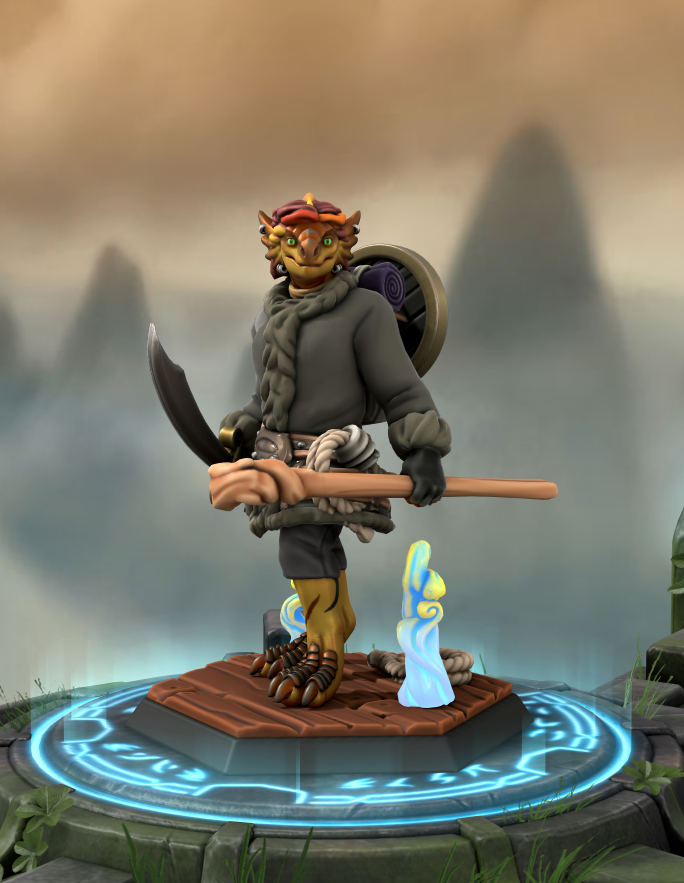 Clanless Nala, built in Heroforge to help me learn more about her
Clanless Nala, built in Heroforge to help me learn more about her
Nala wandered through the trees, tall enough now to reach the lower branches and pull them down so she could look at the veins beneath the surface of the leaves. They looked, she thought, like stained glass in the wash of the sunlight spearing through the forest, all in green, but just as beautiful as anything made by people.
She plucked a leaf that had just begun to turn red around the edges to show her mother and twirled it by its stem between her fingers. Then she continued to explore, following a toad for a while as she hopped her way between the roots of the ancient trees, then sitting still and silent to watch a small blue bird dart back and forth between the ground and the branches, bringing nest-making materials back to his home, and finding a clearing filled to the brim with wild berries; she collected enough to fill the little pouch her father had given her just a few weeks ago.
It was growing darker by then, and so she turned and wandered back the way she came, though she wasn’t quite sure if she got it right. The light was different and nothing looked familiar, though of course it didn’t; this was not their home forest, they were only visiting. Undeterred, she pushed on, knowing soon she’d crest a rise and be able to see her clan’s encampment.
When she came to a stream, however, she knew something had gone wrong. She had not crossed a stream when she left the camp, only wandered over mossy hillocks and shadow-drenched roots. No streams, not even a small one. Determined not to cry–she was not a baby anymore, and hadn’t been for a whole year–she took a deep breath and let it out slowly, then turned away from the stream. She assured herself that she would be fine alone in the dark; she could breathe enough heat now that she could make a torch if she needed. Nodding to herself on that thought, she took a step back into the forest.
“Mother?” she called as she walked. “Father? Biri? Medrash? Thava? Are you there?”
Over and over again she shouted for them, but there was no answer.
“Nala.”
Nala wakes with a start, her heart pounding. Habit has her clenching her jaw to hide the lingering effect the nightmare always has on her. Looking up, she sees Alessia is up and standing near the banked fire, her bedroll packed and ready for another day’s walk, her gaze open as she waits for Nala to wake. Ketlin sits cross-legged next to the ashes, a map spread in front of them, but their attention on a piece of paper they grip in their hand.
The sun is shining through the cave entrance; the snowstorm must have blown itself out during the night.
Better to move than to stew in grief, Nala thinks and sits up.
Ketlin glances at her and says, “I thought the map might help but realized we need to know where we are first.”
Nala nods and clears her throat to get rid of the screams she never let go in childhood. “That’s a good idea. Let me take a look outside, see if there are any landmarks that might help.”
She stands and walks to the front of the cave, pausing only to stretch her back after a night sleeping on cold-hardened ground. Once her sun-struck vision clears, she sees the twin towers just to their east, back the way they’d come the day before. Turning to find Ketlin has joined her, she points down at the map. “I think we’re just here. The crevasse should only be an hour away, I think, if I’ve got the scale of this right.”
Ketlin smiles at her, though the warmth of it leeches away before even a moment has passed, then looks back out across the snow-swept tundra.
“It’s so bright now that you could almost believe yesterday was a bad dream,” they say, their voice soft.
Nala shuts her eyes against the reminder of her first nightmare, of watching Arnam’s body fall while she was held motionless, unable to get to him before he was lost and gone. Unable to bring him back before he, too, disappeared.
“Lucky for us, I suppose,” she agrees, swallowing hard and clearing her throat again. Ketlin pats her arm a few times, and then they break away to pack their things.
Nala casts one more look over the frozen landscape, wondering whether Arnam would hear her if she called to him as she had her clan, before she became Clanless.
Nala is the first D&D character I created. I’m going to be really honest when I say this, I chose most of her options because I thought they were fun, not because I knew what I was doing. I saw a dragon-creature, I went for it. I saw a class built around nature-based magic, I went for it. I saw a background of a globe-trotting sailor? I went for it. It was only after I dug into some of the research after the fact that I thought, oh no, how am I going to make this work? I think I did okay, but you tell me.
Name, Race, Gender, Description, Et Al.
When I decided to play a Dragonborn, I had no knowledge on traditional names, but after about five minutes of research, I found that Dragonborn tend to be introduced by their clan name followed by their personal name, and they might’ve had childhood nicknames. I originally thought I might call my character Naia, then realized that it was very close to a traditional Dragonborn name–Nala–so pivoted. When it came to a clan name, I had no ideas, and I’m playing within an home-brew world, so wasn’t sure of any canon clans in my DM’s world. When I read about Clanless Dragonborn, I realized I could work with my lack of knowledge, rather than bluffing my way through. I don’t have to know my Dragonborn’s clan if she doesn’t know it either. And thus I settled on Clanless Nala. Her childhood nickname was Drifter, given to her by her older brother Medrash, for her habit of drifting beneath the trees as she investigated some new plant or other.
 Close up of Nala’s face
Close up of Nala’s face
Dragonborn, as a rule, are tall, strongly built, and have literal claws. Nala is a Brass Dragonborn in both name and scale-color, can breath fire, and resists fire damage. She has deep green eyes and shockingly red hair that she keeps braided down her back.
For Dragonborn, their clan is their life, and they are bound to uphold the honor of their clan, striving always for excellence. Nala is no different, prideful and self-sufficient to a fault, and with no clan to which to bind her honor, she takes all failures as her own. She gained her love of freedom from her father, though she would not remember it, and feels very strongly that the seas and wild places must be guarded as a refuge for those seeking the freedom she desires.
Backstory & Family Life
Nala was born into a clan as all Dragonborn are, but she does not remember them well beyond the names of her siblings. Even her parents faces have faded from her memory. She was only two years old when she was separated from her clan, old enough by Dragonborn standards to play by herself, but not yet old enough to have a reliable memory. Her father and mother had three other children, Thava, their eldest daughter, Madrash, their only son, and Biri, another daughter only a year older than Nala and often her playmate.
She wandered in the wilderness for days after losing her way, and stumbled upon a druid named Reynword who had made his home in the woods. Reynword, being a bit of a hermit, did not raise Nala, but did help her learn how to survive in the woods and taught her Druidic. She joined his order, the Circle of the Moon, in honor of him and to honor her love of the wilds as well.
When she was 15, and by Dragonborn standards, an adult, she began to feel restless in the forests and opted to leave to find the sea. She signed on as a cook’s assistant and backup healer on a ship of discovery called The Wanderer and saw many strange and wonderful things on The Broken Sea because of it. After ten years, however, she missed the solitude of the forest, where no one would panic if she spent time as a wolf or a bear, and resigned her post aboard the ship, ending up in Nook, a port city on the Eastern edge of the Broken Sea. She wandered from there, always coming back to Nook as a place to resupply. As of the start of the campaign, she’d been in Nook for three months, unable to force herself to leave despite her itchy feet, and elected to stay, certain that fate was guiding her.
Initial Class & Changes Made Over Time
I set Nala up as a Druid of the Circle of the Moon at level 2. This meant that she could cast spells, and gave her the ability to change into more dangerous animals than another Druid would be able to and much quicker as well. Since the start of the campaign, she has leveled up twice, and is currently a level 4 Druid of the Circle of the Moon, and I don’t see her branching out from that path any time soon. She is determined to be the best druid she can.
Background & Previous Careers
Nala, having sailed on The Wanderer, has the Sailor background. She is forever bonded to the crew of that ship, as they were as good as her clan for 10 years. When she needs to, she can secure passage on any ship for herself and her companions. So far, she has not needed to use this feature, as she and her companions were instead hired to join the crew of The Broken Bone, a ship of discovery captained by Captain Selsi. The first mate, Arnam Troth, is played by one of the other players, with Ketlin Bakderl and Alessia Oakenheel rounding out the table. Nala’s sailing, cooking, and healing experience were deemed worthy of Selsi’s mission to find a lost city, though she’d only been seeking Ketlin’s research prowess. Similarly, Alessia hopped aboard in a quest to prove her worth to her ancestors.
Daily Carry & Weapons of Choice
Nala has collected or thrifted everything she owns, given that she left her family with only the clothes on her back at the time. After leaving The Wanderer, she crafted her own leather armor under the tutelage of an armorer in a small town. She’s got a scimitar and shield that she learned to wield on the deck of a ship. Her druidic focus is a wooden staff she carved from a fallen limb of an oak tree. Given her time clambering over the rigging of a sailing ship, Nala always has at least two bundles of rope, convinced she can use it for anything.
In her pack, she carries the typical adventurer gear, but has two momentos that she keeps within reach at all times. The crew of The Wanderer gave her a belaying pin carved with the name of the ship for her to carry with her into her future when they set her ashore, and she carries it on her hip like a dagger, often using it as a Shillelagh in battle. She also has a small stone with a hole carved in the center by sand and time that she wears on a string around her neck. The healer aboard The Wanderer taught her that if she wore it around her neck, it was a symbol of luck and protection, and Nala has never taken it off willingly.
Spells in Use
Cantrips
- Produce Flame
- Shillelagh
- Thorn Whip
Level 1 Spells
- Cure Wounds
- Entangle
- Goodberry
- Healing Word
Level 2 Spells
- Healing Spirit
- Moonbeam
- Spike Growth
Feats & Stories
Nala, since joining the crew of The Broken Bone, has gained one extra ability, though she is unaware of it herself yet. After a traumatic fight in the windswept tundra, she and her surviving companions fell asleep, and when they awoke, Nala had developed a curious telepathic ability. She has not yet noticed this phenomenon, attributing the times her friends hear her thoughts to her being unaware she’s spoken aloud, and the accidental use of Detect Thoughts (a spell she can use once a day due to her ability) to being able to read the body language of the foe. I’ve attributed this feat to the fact that she fell asleep wishing she could speak to Arnam, who had fallen to two ice direwolves on the tundra and to whom Nala could not reach before he died.
Important Moments in World
Since joining her companions, Nala has had a couple of important growth moments. She is not one to trust quickly, but does feel as though she owes the people with whom she’s traveling. But with Alessia, there was an instant connection. They shared stories in a tavern in Nook the night before joining the crew of The Broken Bone, bonded over their first battle when Nala needed to heal Alessia after she was thrown into the sea, and then over Alessia’s desire to learn another language. In the military port of Northwatch, they wandered the market together and Nala helped Alessia find a bearskin to wear to honor her ancestor, and was just as smitten with a cute little owl that Alessia purchased and named Bobbles.
While taking a few days to find a missing captain from the Northwatch garrison, the companions were walking through the tundra and were set upon by two massive ice direwolves. In the battle, Arnam Troth, the first mate, was killed by the wolves, and before Nala could get to him and heal him, his player rolled three failed death saves. All three of Alessia, Ketlin, and Nala were left distraught, fought off their grief, and had to gather Arnam’s supplies, burn his body to prevent it from being eaten by scavengers, and find shelter from a snowstorm bearing down on them. Nala opted to keep Arnam’s carpentry tools, deciding to learn to honor his memory. All three of them realized they did not know the man as well as they wanted, and were grieving him and their lack of getting to know him better.
The next day, when they set out to finish their mission, they were going to climb down into a huge crevasse to find the missing captain when Ketlin slipped. Nala, already traumatized by losing Arnam, attempted to cast Entangle to catch her falling friend and missed. Ketlin was able to use Misty Step to save themself, but the failure haunts Nala, as she believes she needs to be able to save everyone.
At the base of the crevasse, the three of them were set upon by ice gnolls that attempted to drag both Ketlin and Nala off as a snack. In the midst of this, a celestial sent Arnam back from the dead and Arnam saved them all. It took a long time for any of them to believe he existed, and Nala feels endless guilt over burning his body, though of course he had a new one. Though Arnam, decidedly their protector on this journey, is back, Nala has been feeling more and more protective of her friends, scared to lose any of them.
Looking Ahead
As of writing this, Nala is currently in a very strange library beneath a glacier with her friends and the missing Captain Raloren. I have no idea where this journey will take her, but I know for a fact that during the next downtime period, she will be focused on creating healing potions, learning how to use Arnam’s carpentry tools from Arnam himself, and continuing to study druidic magic in an attempt to master that magic. She may also teach one of the others how to cook, because when it is not her turn by the evening fire, she usually has to grin and bear the rations. Whether Nala ever finds her original clan is up to my DM, but I would be curious to know what they’d think of her now, and if she could ever reclaim her clan name.
15 July 2022
character-profile
dnd
Desk Day - July 2022 - Writing
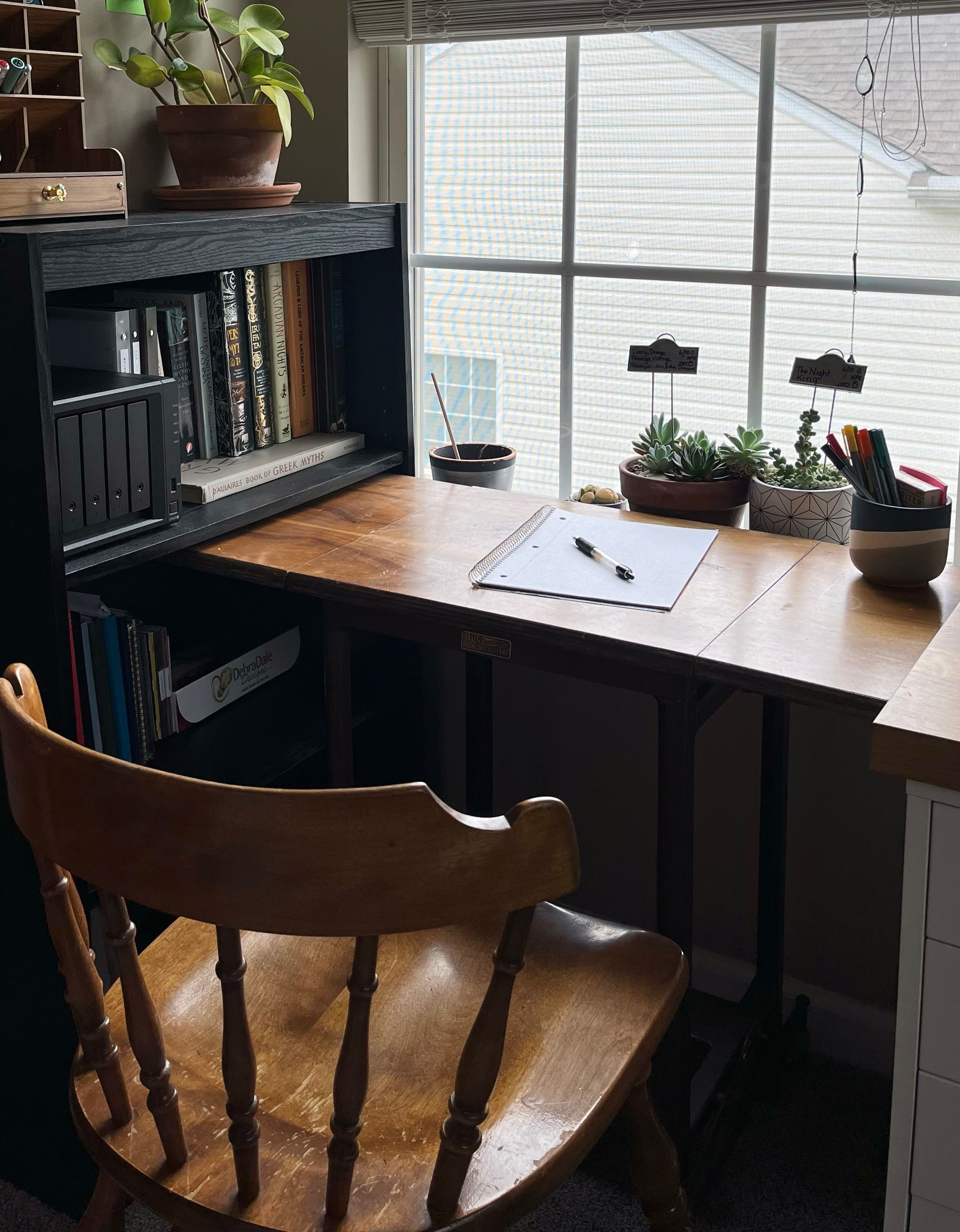 Writing desk on the south wall
Writing desk on the south wall
Happy Desk Day! This month has flown by for me; there have been a lot of changes on this side of the screen, but I’m not quite ready to share them. Instead, it’s time for the next desk in my office, and I’ve opted to show off my tiny writing desk.
At the beginning of 2020, my partner was browsing Facebook Marketplace for gym equipments. This was the height of the surge for home gyms because of the pandemic. Our gym had permanently shuttered its doors, so we were trying to decide whether we waited the pandemic out or if we went for the home setup. That day, he hadn’t found anything we needed, but he sent me a link to a listing for a vintage drop leaf desk. Knowing me as he does, he knew I’d like it, but I don’t think he knew I’d immediately claim it and run out to get it… which I did. It was a steal, what can I say?
Turns out he’d stumbled on an antique that someone didn’t realize they’d had. It’s an early 20th century typewriter stand–a Hi-Lo Typewrite Stand by Metalsmith–produced in bulk for the burgeoning office culture. So I bought it home, wiped it down, and wedged it into a corner of my office to separate my writing sessions from my day job. At first I used a folding chair we’d somehow acquired but have since upgraded to a cute wooden thrift find that is surprisingly comfortable!
I write my first drafts by hand; I find this allows my thoughts to flow without getting caught on typos or grammatical errors. And though the view out that window is the side of my neighbor’s house, having the morning light fall across my page is delightful. At the moment, the pen cup has a pad of sticky notes for thoughts that pop up while I’m trying to focus, a deck of brainstorming cards, and a set of colorful pens for editing, as I’m currently working through the edits on a novel.
To the right is my main desk with sand timers to help me get in the zone within reach, as well as a scented candle and my HomePod mini for soft music while I focus.
To the left, I’ve got a bookshelf with a pen organizer and plant in easy reach. The first shelf holds our Synology for a home server, archive binders for my planner, and the bevy of books I’ve collected about mythologies and legends from around the world which are particularly useful as research for my ongoing project.
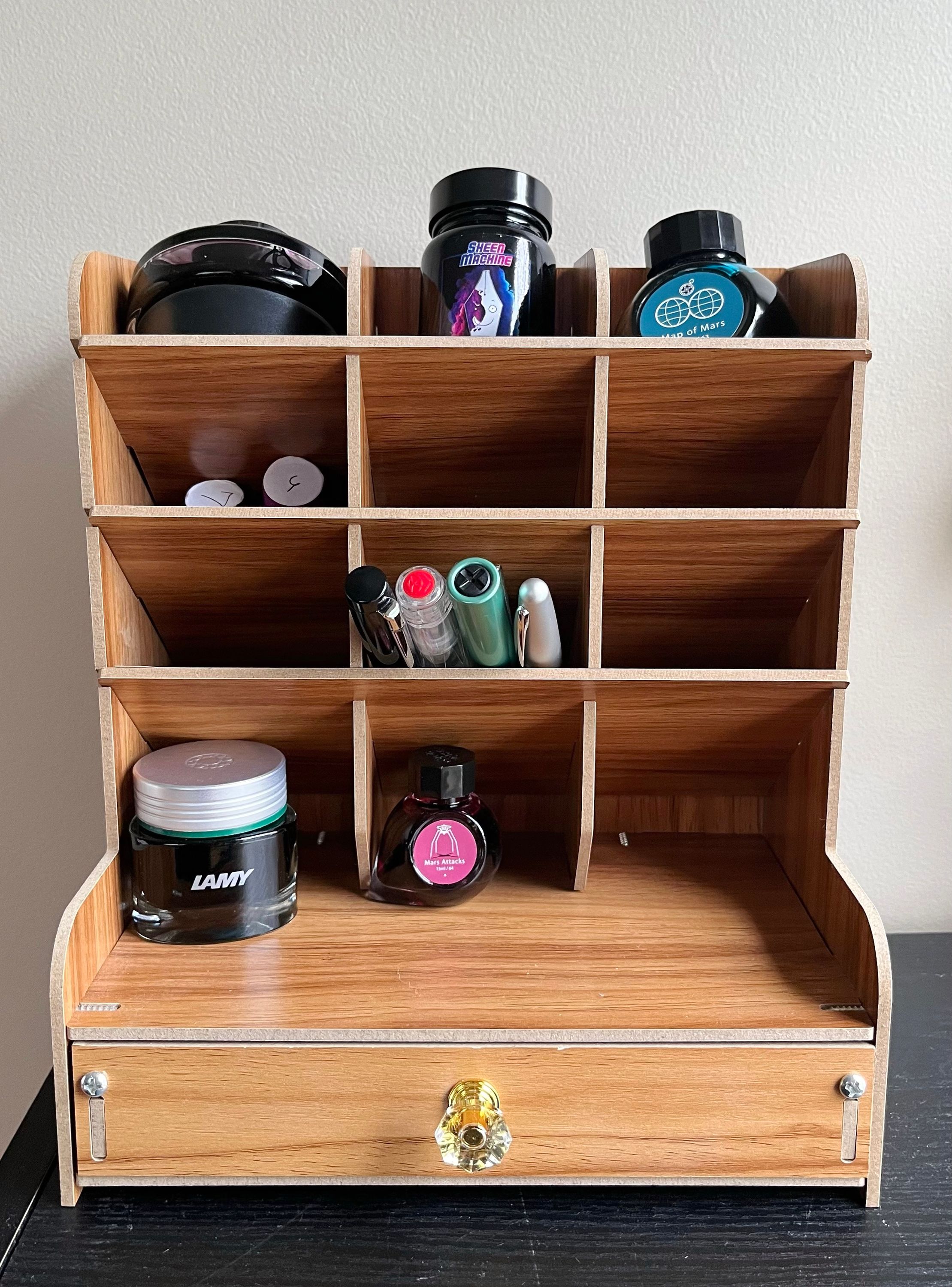 Pen organizer with a selection of inks and fountain pens
Pen organizer with a selection of inks and fountain pens
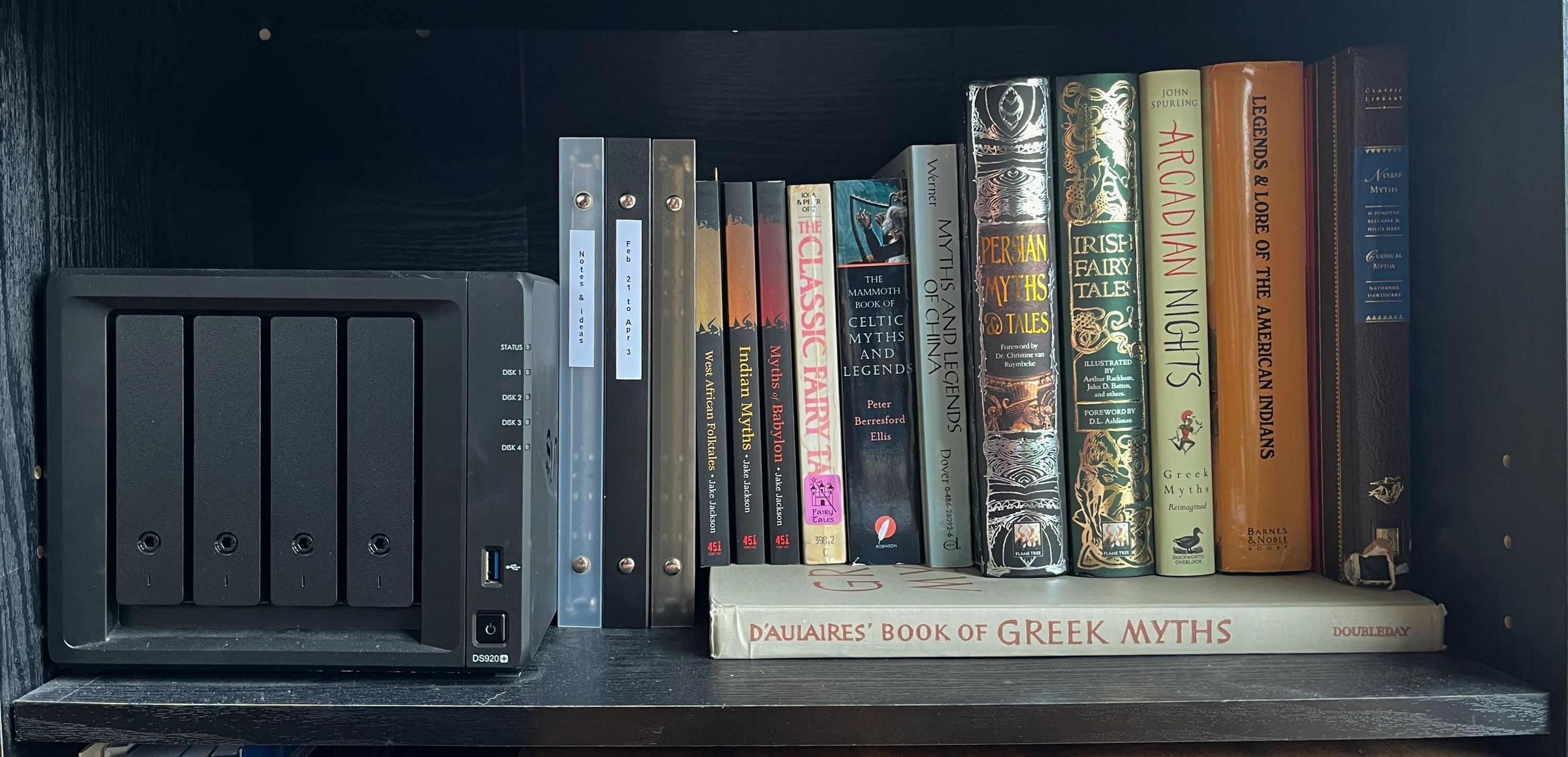 Top shelf of the bookshelf with research material
Top shelf of the bookshelf with research material
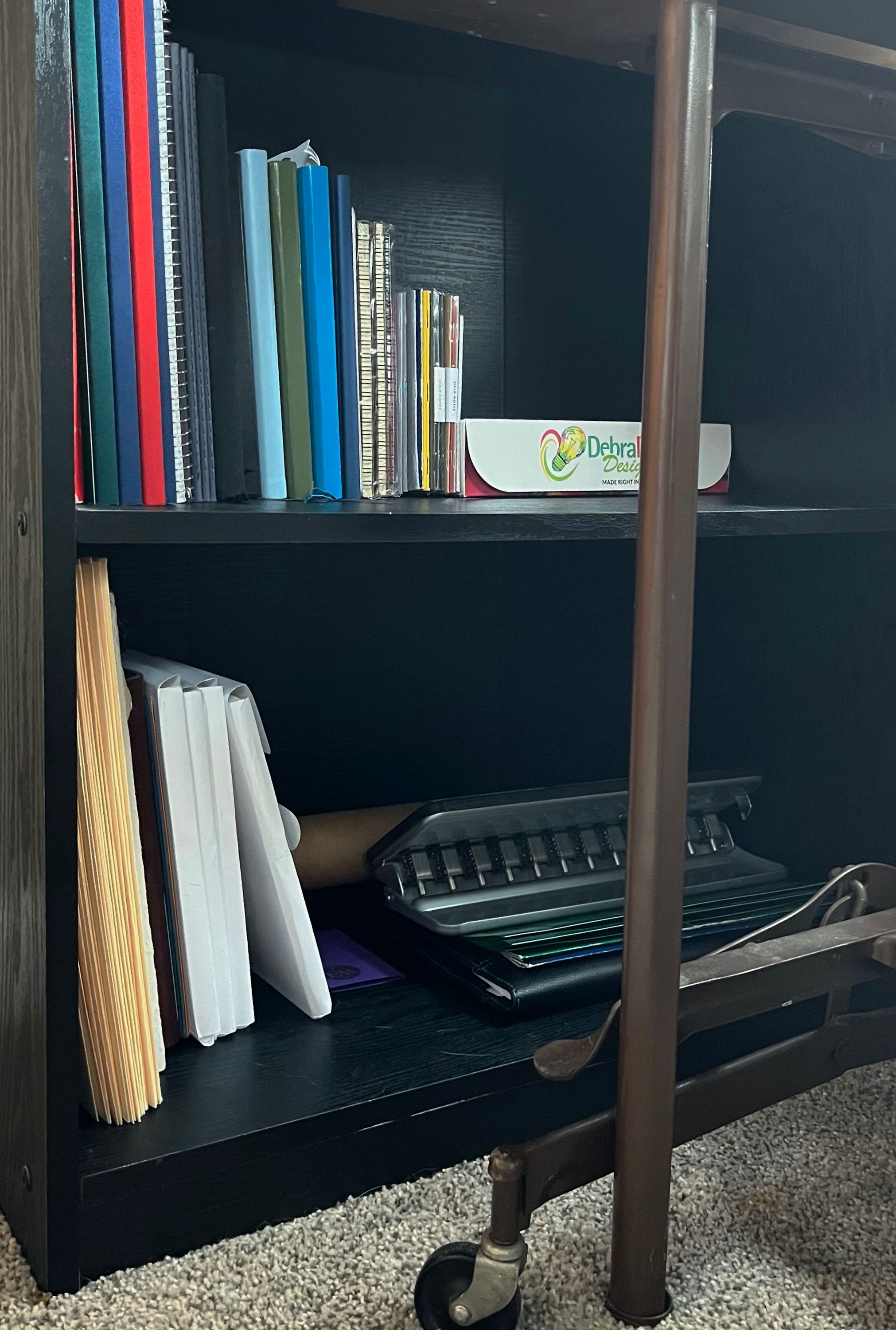 Lower shelves with a selection of less-used items
Lower shelves with a selection of less-used items
With some careful maneuvering, I was able to fit the left leaf of the typewriter desk under the top shelf of the bookshelf in order to buy myself back a smidge more room. Beneath the leaf, there are two more shelves, with the middle holding notebooks and paper of various sizes. The bottom shelf has an old binder system as well as some empty manila folders and some game books. I don’t need them much, so I’ve put them as far out of the way as I can!
Overall, this desk is one of my favorites, because it feels like the perfect spot to sit, sip a cup of coffee in the morning, and get some words on the page.
13 July 2022
desk-day
office-organization
Woodland Clean Up
The neighborhood in which I live is managed by a Homeowner’s Association. This is not my first choice of arrangement, but it’s the one we have. The HOA is paid dues by the homeowners and those dues are put toward maintaining the community areas such as the pool, parking lot, the entrance, and in theory, the nature path that winds past the ponds in the center of the neighborhood.
My partner and I have always walked our dog Jinx on this path, and when we adopted Belle, she began to join us. The layout of the path is such that it starts from the pool parking lot and heads north, past the first of the ponds (which we have always called Top Pond, because we are very original). It splits into two directions, one path heading east to go toward what used to be an outdoor grilling area, and the other continuing north, down into a gulley, following the path of the small woodland stream that connects Top Pond to the main pond (which we’ve always just called The Pond, because again, we are very original). The path continues north along the western edge of the pond, turns right to follow the northern shoreline, and the comes back south to the narrow end of the pond, where a small wooden bridge spans about 4 feet of water to make a loop.
In all, the walk from our doorstep, to the ponds, around the circle and back is exactly a mile, so it makes the perfect path for walking or running, so we go down there often. So when I say that the theory is the HOA should tend the nature path, what I really mean is they never do. They used to mow every month, something I’m not a fan of, but gave that up at the start of the pandemic. They hired someone to weed wack, but again, not a fan. Most weeds are just native plants that have found a convenient patch of earth. Three years ago, when a beaver elected to make The Pond its home, the only maintenance provided by the HOA was to tear out the beaver dam and hire someone to trap the creature. This is also not a good thing.
All the while, invasive plants were creeping into the edges of the woodland. Kudzu tumbling over the top of crepe myrtle trees and leaping across distances to span the path and smother more. Multiflora roses bursting into brambles that weren’t there before. Privet stands so dense that it is actually dark beneath them, blocking out any light from reaching the native seed bank dormant in the soil. Japanese honeysuckle runs rampant too, attracting pollinators but felling young saplings while mimosa trees–gorgeous but horribly invasive–grow tall, die, and fall, only to be replaced by another.
So early this year, when I was prioritizing exercise for the sake of exercise, I chose to walk that mile every morning–except in absolutely pouring rain, because it can get very slippery down there when we get a rainstorm dropping inches in an hour–and began noticing these things. It was little discoveries at first, like the startling pink of a pinxterbloom azalea back in the woods. The tumble of honeysuckle weighing down a black cherry tree on the western edge. I brought a plastic bag with me to pick up litter as I walked, then realized that after I’d done that, it would be so simple to bring a pair of snips with me to cut back some of the encroaching brambles or to try to control some kudzu. Soon I was waist deep in plants, fighting with a thorny olive vine that had the audacity to punch a hole in my glove. My toolkit grew, expanding from one pair of snips to include my gardening gloves, a small folding saw, a trowel–which was replaced a month later by the much more versatile hori hori–a hand rake, and more.
I learned as I went, swapping out my nitrile gardening gloves for tough leather gloves after getting stuck in the palm by some brambles one too many times. Recognizing Japanese honeysuckle as compared to coral honeysuckle on sight made it easier to feel confident at ripping up some of the vines. I pulled down privet stand after privet stand, allowing the sun to shine through and encourage the native seeds beneath to get their chance. I began marking the natives I found with nameplates so that others might learn, starting with a southern wax myrtle that had needed help just to the south of the bridge. I beat back some kudzu, helped along the natural dams forming in the creek bed, and shrieked in pure unadulterated joy when I saw that we’d had another beaver move back in. She soon had a friend join her, and they’ve been building dams and a den as they start their lives. The HOA promised that they wouldn’t do anything to the pair, as I expressed to them how vital beavers are to their ecosystem, and our new friends–who I lovingly call Hope and Chonk–aren’t in danger of damaging any private property.
Every day, I see someone from the neighborhood, and they ask me what I’m doing. I’ll say that I’m helping tend the pond and give them more information on the plants I’m touching at that point in time. I’ll explain how each plant fits into the ecosystem, or doesn’t, and my next few projects. And every time, I say, “if you ever feel like helping yourself, feel free.”
The ponds are ours. They belong, in the eyes of the law, to the HOA, of course, but the HOA represents hundreds of families. Each time I take up my shears to cut down swaths of Chinese bush clover, or cut down a kudzu vine that’s drowning a pine beneath its weight, I am telling the woodland that I am here for it, that I will help. It started with walking for walking’s sake, but it continues every single day for me now. I strap on my tool belt, grab a five gallon bucket, and tackle some small section of the woodland. It’s more exercise than I ever got just by walking; I come home dripping in sweat and with dirt smeared on my arms. I have watched sections of the woodland transform from crowded by invasive plants to a glen filled with a variety of native plants I didn’t even know to look for. And I won’t stop until we move. I only hope that some of my neighbors take up the mantle before I’m gone.
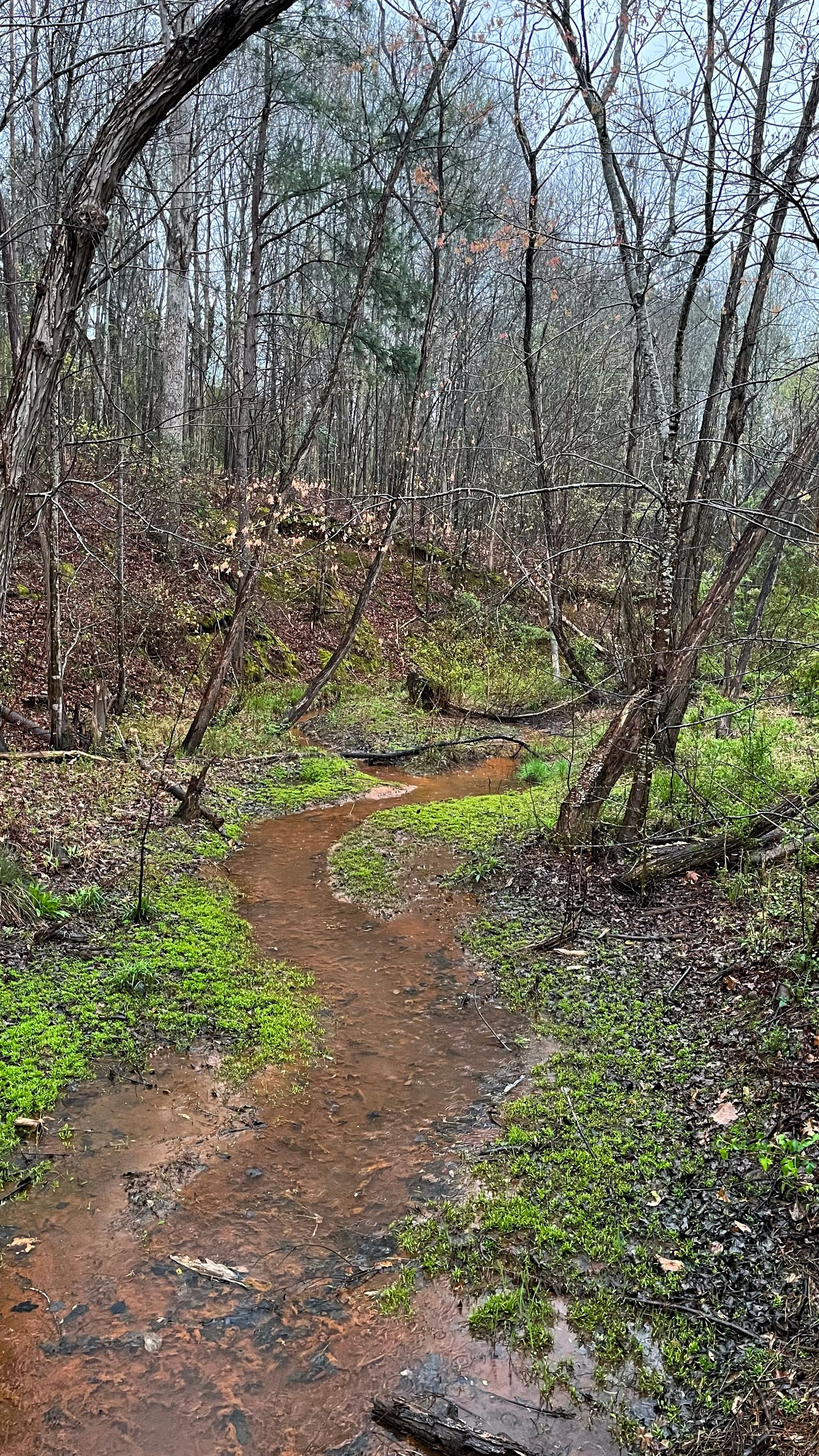 Where the creek meets The Pond, seen from the bridge
Where the creek meets The Pond, seen from the bridge
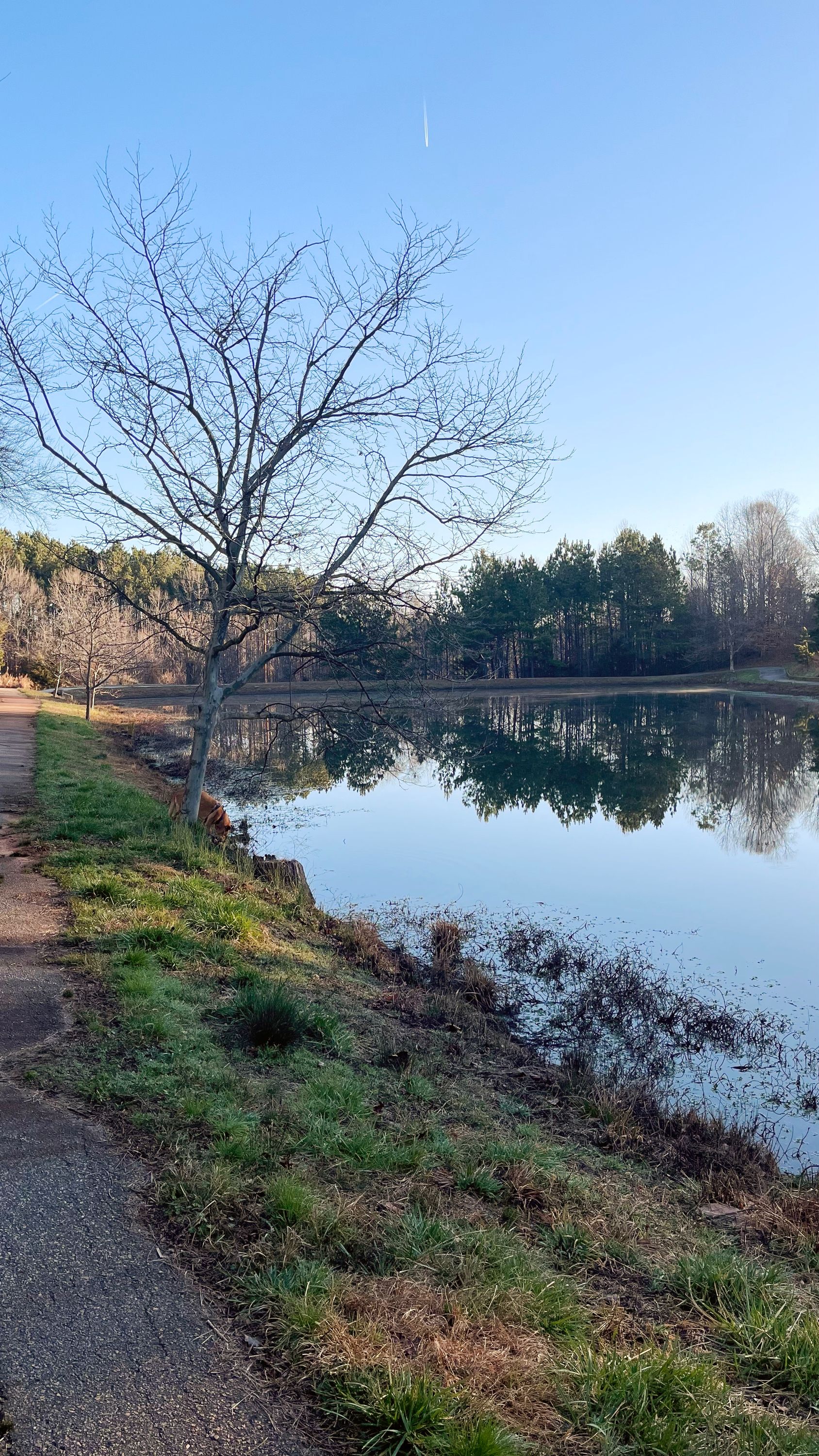 The Pond in late winter, with Jinx sniffing at the bank
The Pond in late winter, with Jinx sniffing at the bank
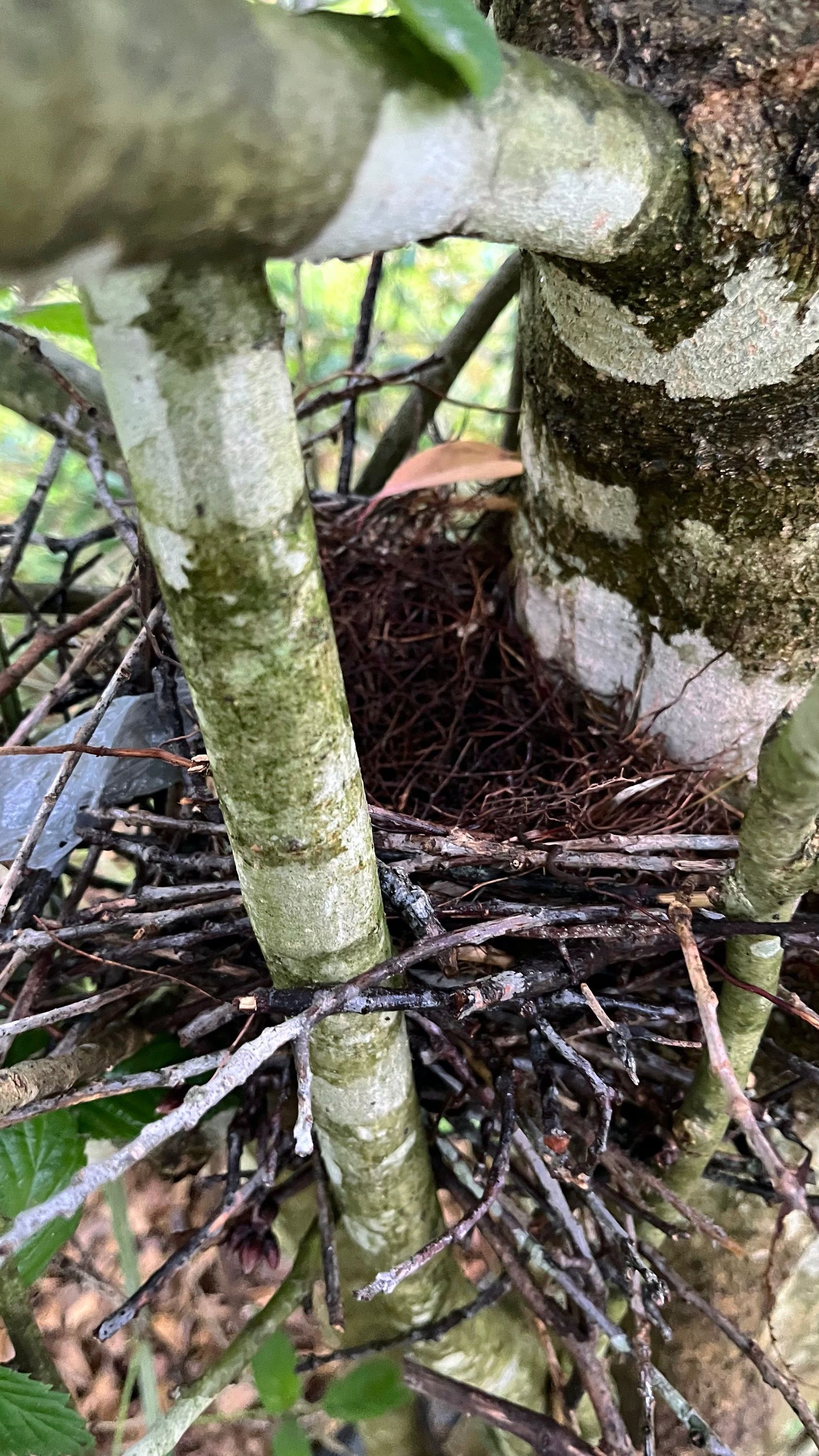 A nest in the crook of an American Holly tree, not in use
A nest in the crook of an American Holly tree, not in use
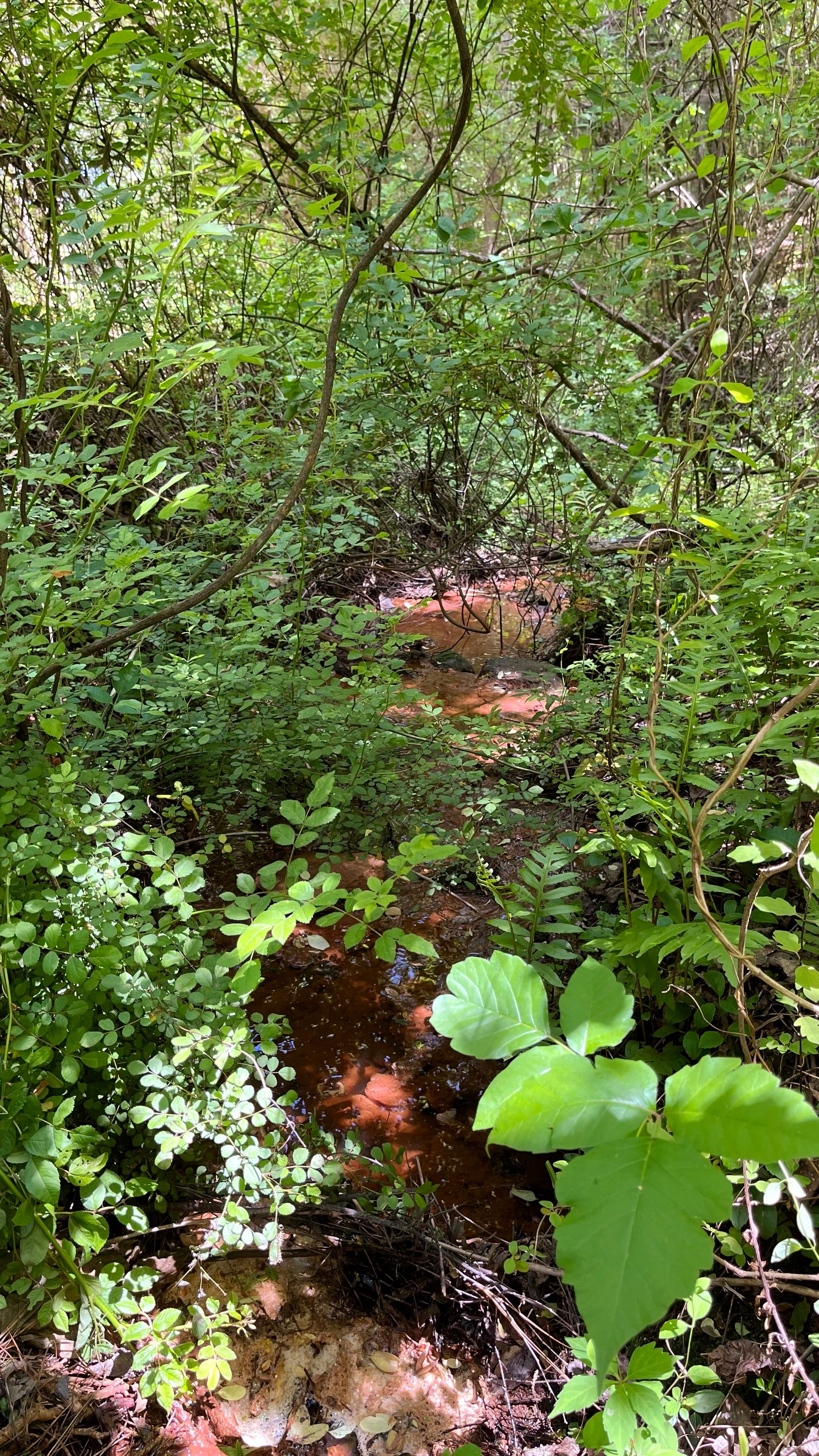 A view downstream from the top of a natural dam formed by a long-fallen tree
A view downstream from the top of a natural dam formed by a long-fallen tree
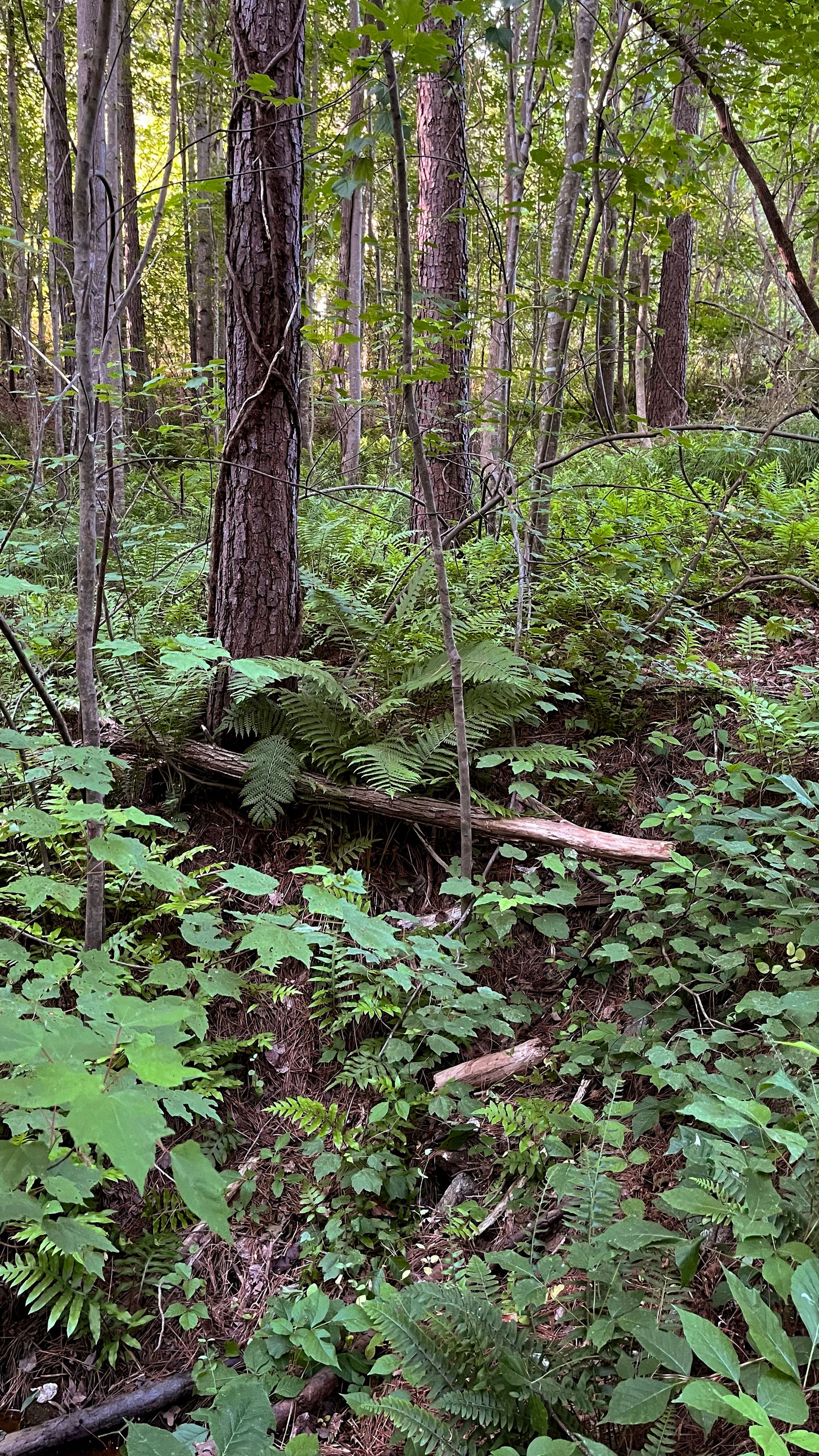 A glen filled with ferns in the early morning light
A glen filled with ferns in the early morning light
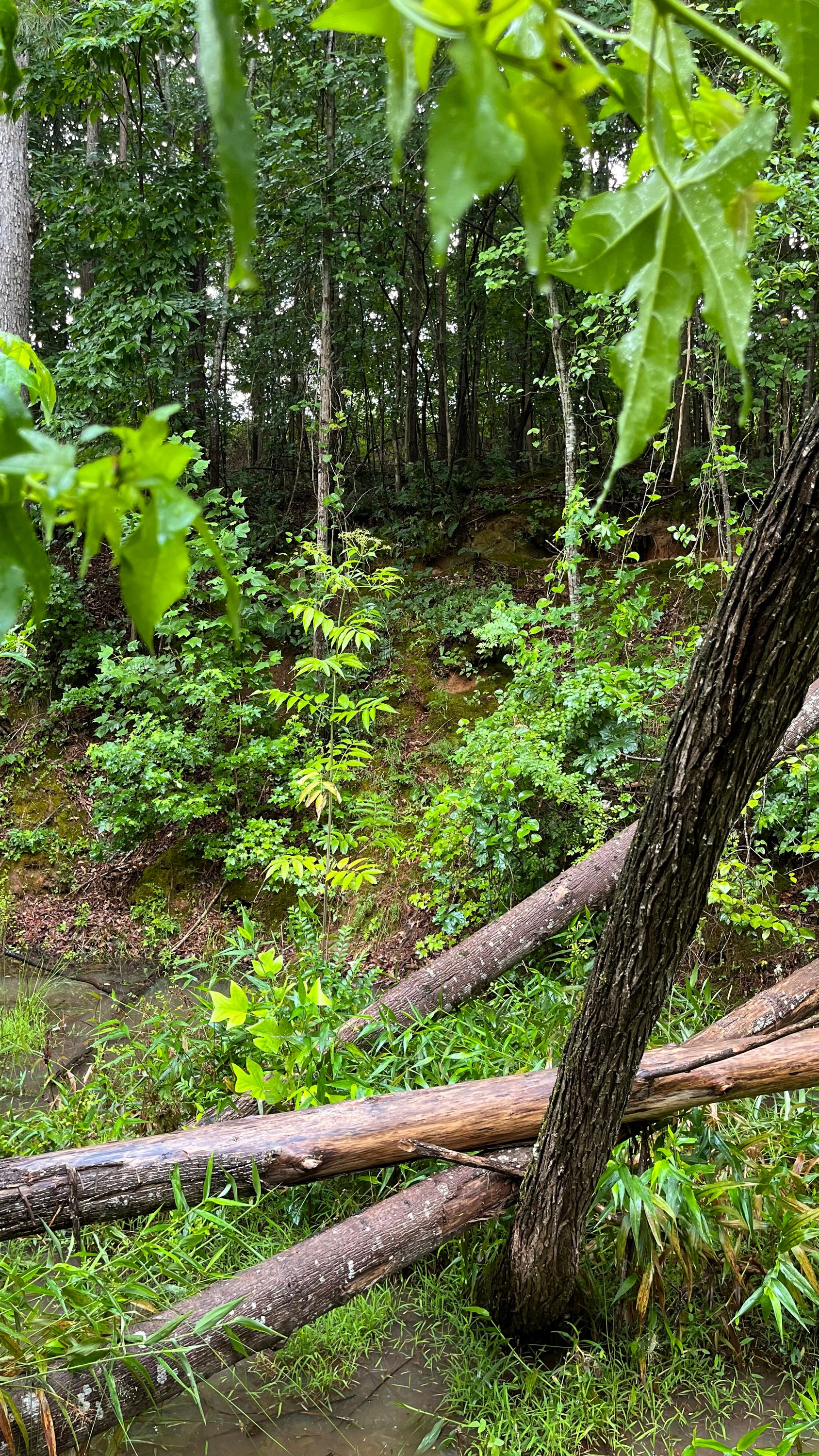 Where the creek meets the pond now that Hope & Chonky have built a dam to create a small marsh
Where the creek meets the pond now that Hope & Chonky have built a dam to create a small marsh
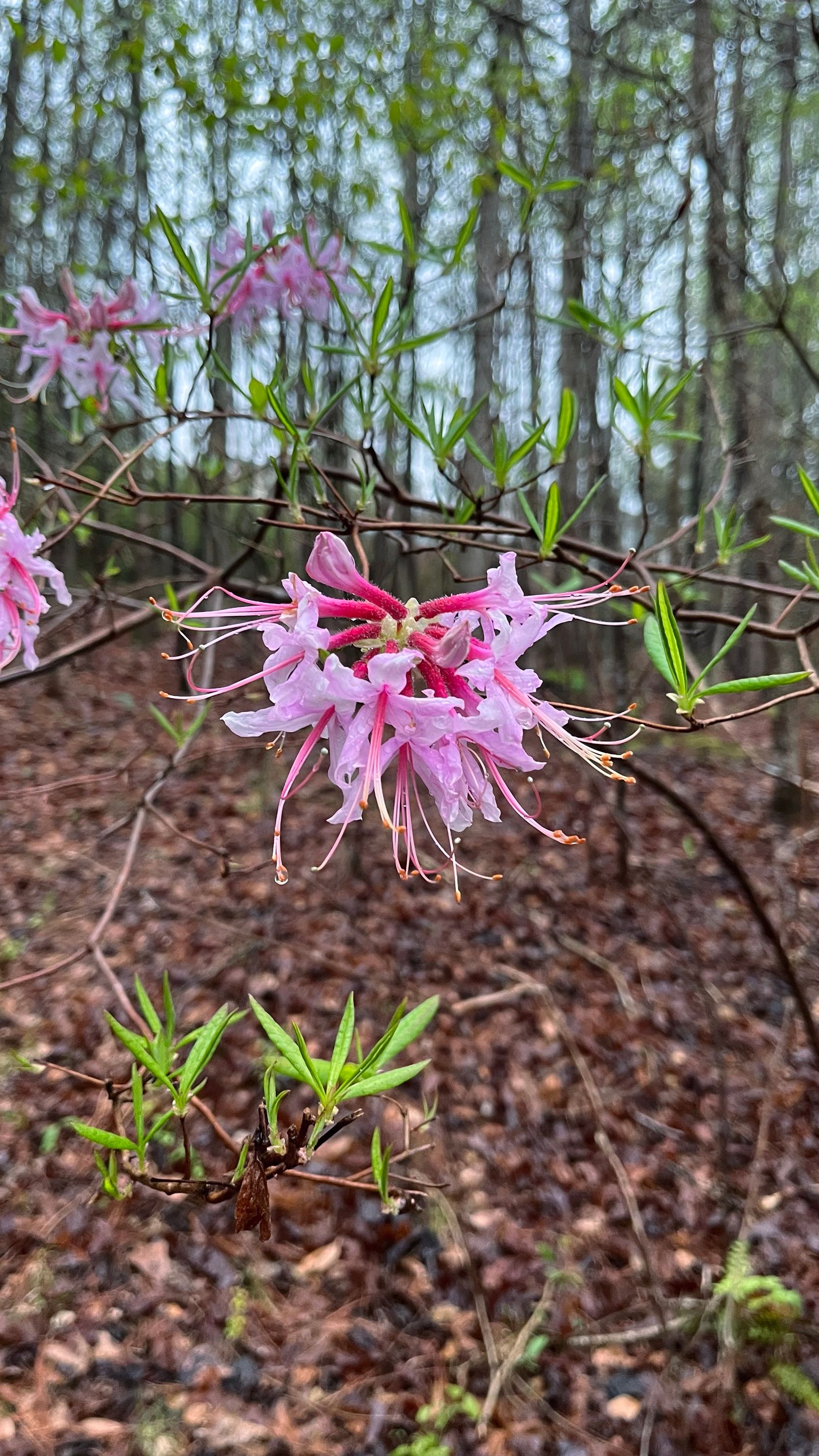 A pinxterbloom azalea in shocking bloom in early spring
A pinxterbloom azalea in shocking bloom in early spring
 A black cherry tree that was previously smothered
A black cherry tree that was previously smothered
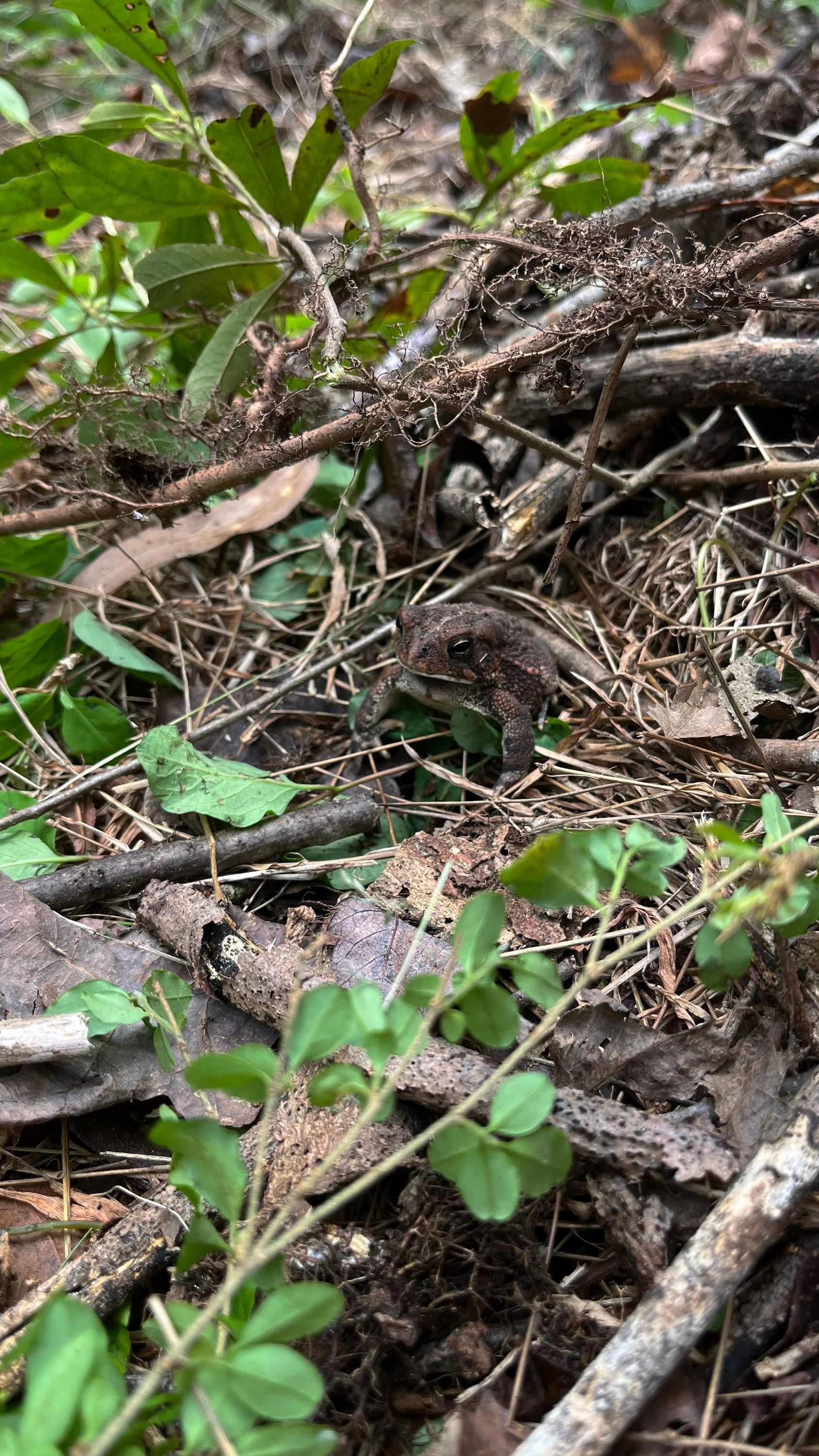 A woodhouse toad wondering what the heck I’m doing
A woodhouse toad wondering what the heck I’m doing
 Hope, the smaller of the two beavers, finding some delicious plants to munch
Hope, the smaller of the two beavers, finding some delicious plants to munch
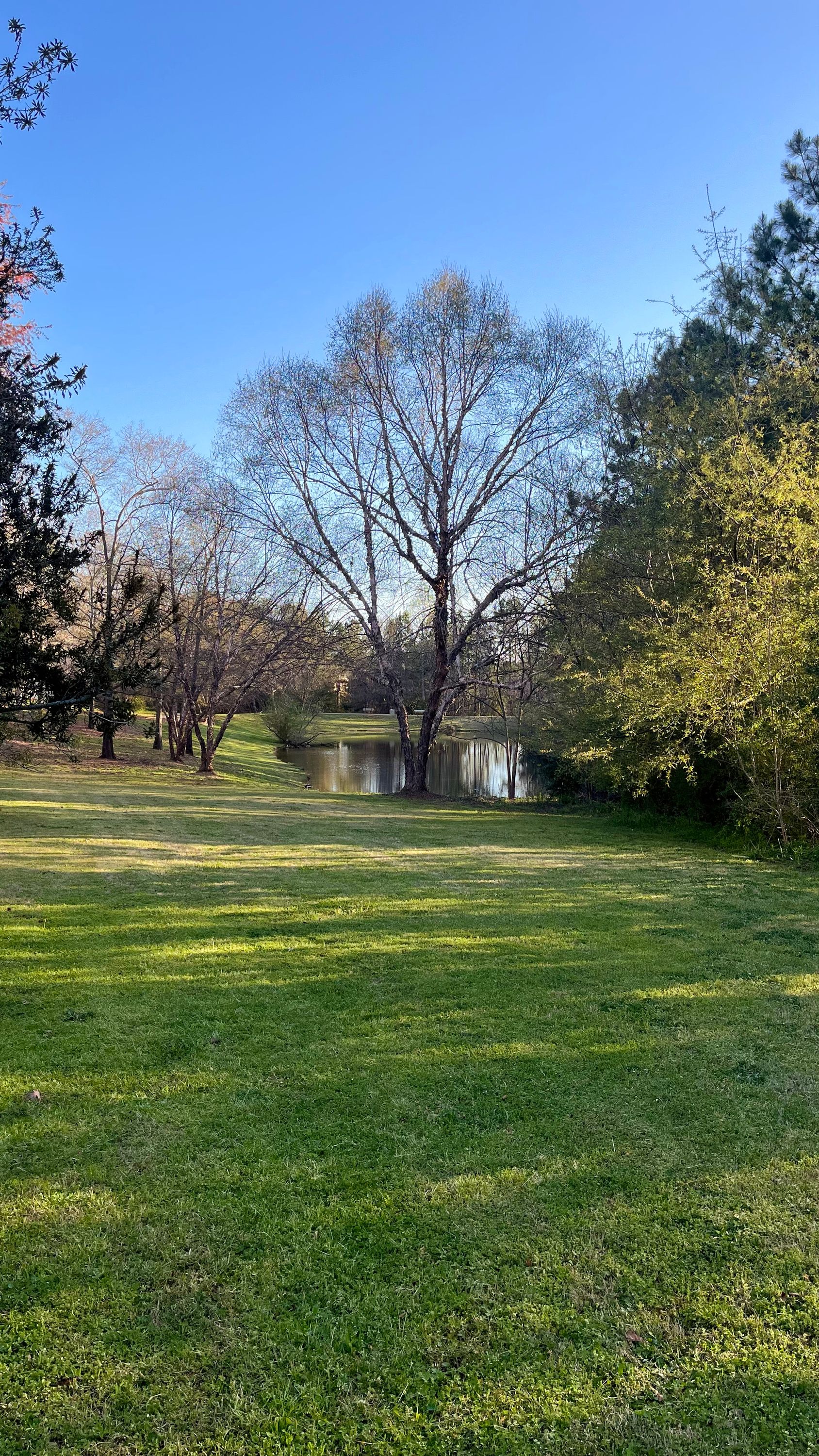 Top Pond, seen from the start of the nature path
Top Pond, seen from the start of the nature path
 Blackberries and black raspberries fruiting at the woods edge on the west bank of The Pond in midsummer
Blackberries and black raspberries fruiting at the woods edge on the west bank of The Pond in midsummer
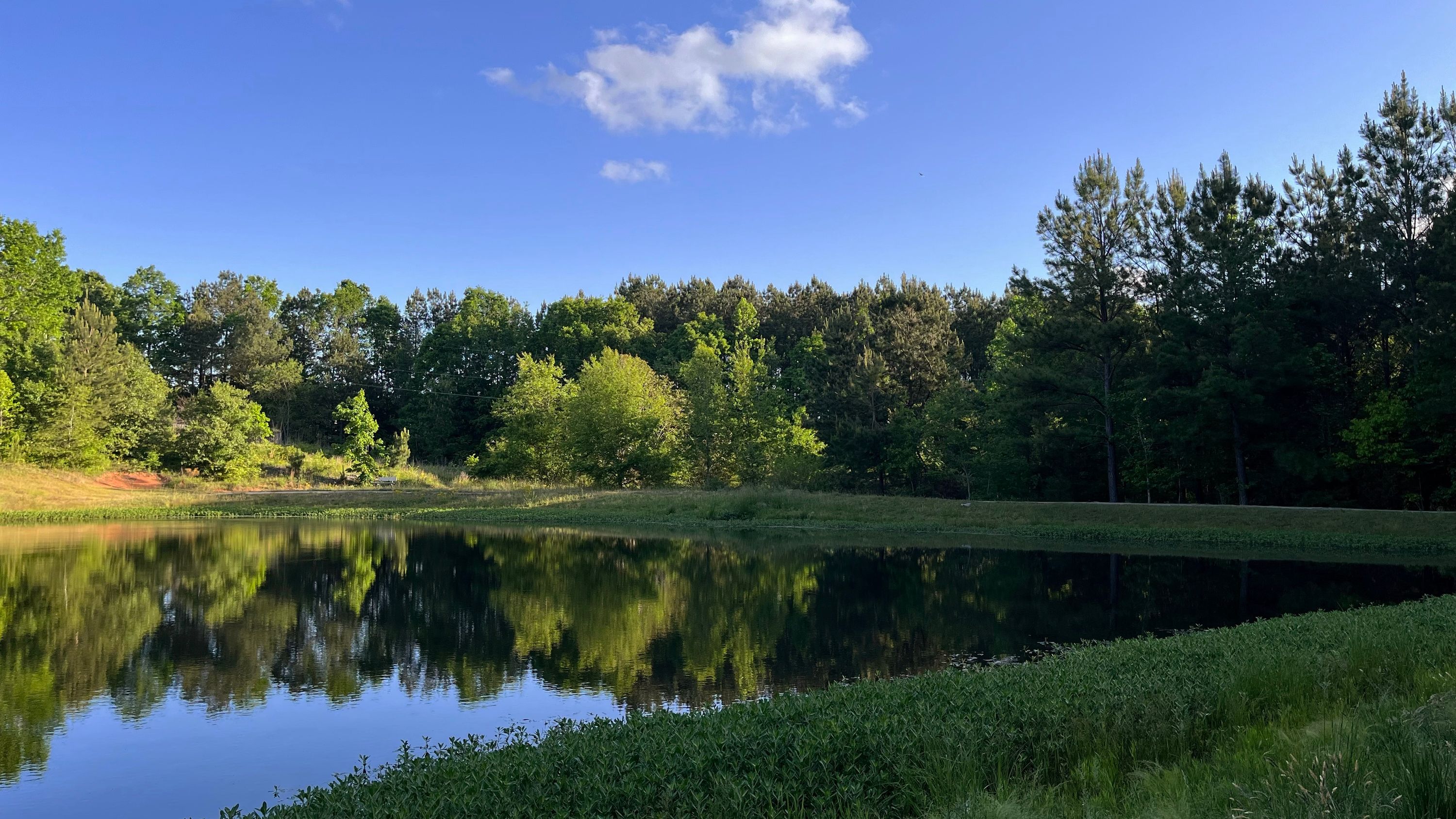 The north end of The Pond, seen from the eastern path
The north end of The Pond, seen from the eastern path
11 July 2022
native-plants
projects
plants
One Year With Belle
Last year, almost to the day, I was driving home from an appointment, listening to a podcast, and thinking about everything that needed to be done before I logged off of work the next day and left town to stand up for one of my best friends at her wedding. I was driving in that way that your eyes are on the road but your mind is elsewhere because you have driven that path so many times, it’s habitual and instinctive. There’s a light at a small intersection that is green 90% of the time I’m driving down it, but on that afternoon, it turned yellow, and I started to slow down.
Fate, destiny, the universe, what have you, must have been there that day, because seconds before I reached a full stop, a brown dog darted out into the road in front of my car. It was off the road again in another instant, but I knew that if I didn’t pull over, that poor thing would get hit. If not soon, then after dark, when someone would be speeding down that road and wouldn’t be able to see it.
So I rolled slowly up to the light and turned right, pulling off the road a ways and leaping from the car. The dog had turned right too, and was twenty feet away, staring at me like I might just be a monster, with a minivan coming straight at it. I waved at the driver as I called for the pup, and she moved out of the road and into the grass, still far from me, but seeming to think I might just be okay.
It took maybe two minutes to convince the creature to approach, calling it with an excited voice, clapping my hands encouragingly, whistling to draw its interest. Eventually twenty feet was reduced to two, and I reached out slowly to grab the collar around its neck, thinking I’d find a tag and drop it off.
When my fingers curled around the collar, the dog flipped over onto its back like I’d whipped it. This is when I saw first, she was a girl, second, her ribs were too pronounced, third, she had scars across her body–some old, some new–and, fourth, there was no tag on her collar.
I called my partner, informed him I’d be bringing a loose dog home, and that he might want to make sure our dog Jinx was inside, because I’d bring the lost puppy into the backyard. He did just that; it’s something we’d done for around five dogs we’d come across loose before, some of whom became frequent visitors. This seemed no different except that we had no idea who to call about this poor thing.
When we got her back to the house, we gave her water and some food, thinking that would calm her, and then watched her run around our backyard like she owned it, trying to get Jinx to play. Our vet was closed, so we couldn’t check her for a chip with them, but with a quick call to a local emergency clinic, they said they could check her for a chip.
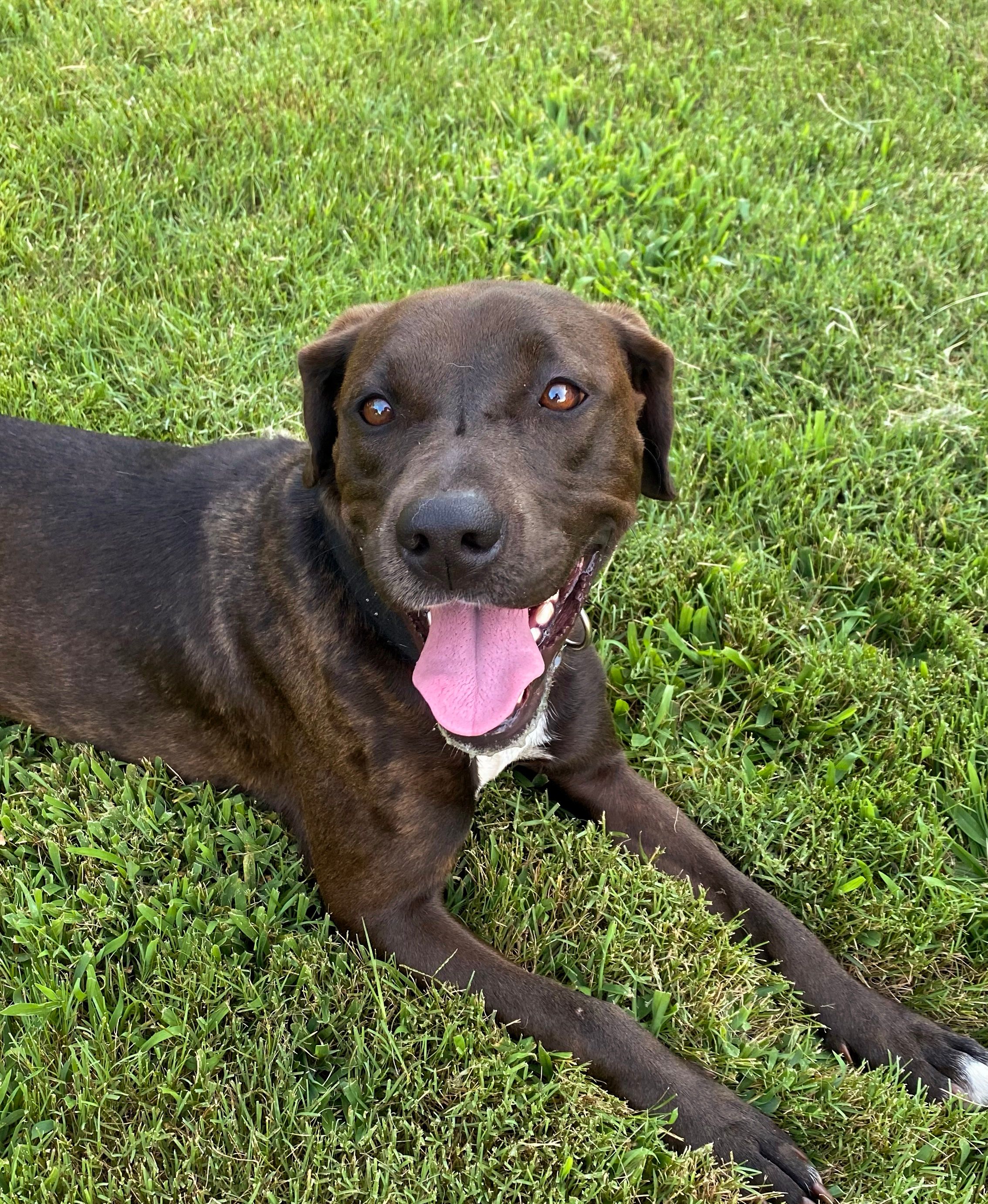 First day we knew her
First day we knew her
So back into the car I went with the cute little creature who kept rolling to show me her belly and seemed completely disinclined to hurt a fly, though she had the look of a bully breed to her face. Fifteen minutes later and the vet tech comes out to the car, asks me to hold the dog while she scans for a chip and finds absolutely nothing. No chip, no way to contact her owners, no way to figure out where she came from.
The vet tech mentioned that she looked young, only about a year old, and underweight for her size. We talked about options–where could I bring her to find her owners, what my next steps should be, any basic questions the tech could answer on sight, then got back in the car and drove home.
With her poor manners and our worries about how our older dog might react to have another dog in her home, we kept them apart, and I slept with the puppy in the guest room. She spent the entire night trying to crawl inside me, wanting to be held, wanting to be near my face, as if she was worried I would disappear. With the lack of sleep and a stray I had no intention of keeping, I took the following day off work, got a vet appointment scheduled, and started trying to figure out what to do with her, calling the county animal shelter and the local humane society, hoping they’d be able to take her in and find her owners, especially as we were meant to go out of town in less than 24 hours.
At the time, we were still in COVID protocol, so when I brought her to the vet appointment, I wasn’t allowed to go in with her, and I had to tell the vet tech that I’d literally picked her up on the side of the road, that I had no idea what shots she’d been given, or even her name. They needed a name to start her chart, so I looked in the backseat, where she was laying belly up in a mix of fear and desire for belly rubs. Belly seemed appropriate, but didn’t feel like a name, so I told them, “Let’s call her Belle.”
I helped them get Belle out of the car, since she seemed loathe to leave it, then watched as she disappeared inside to get a full check-up.
Two hours later, the vet herself came out and asked for her full story again. I gave it, and the vet told me, “Congratulations, you adopted a dog.”
Over my protests that I couldn’t, the vet told me that Belle had tested positive for heartworm, an incredibly fatal disease for dogs, had roundworms in her waste, was 35 pounds and underweight, and hadn’t been spayed. They’d given her the full battery of vaccines but hadn’t been able to get a look at her ears because they were very sensitive, and when they thought to let her hang out with the vet’s two golden retrievers to calm down, hadn’t reacted well. This was baffling to me, because I’d been ruffling Belle’s ears constantly, and she’d had no problem with Jinx besides being over enthusiastic and having poor manners like she’d never been socialized. The vet gave me a bill that made my eyes pop and then said that I needed to decide about how to handle the heartworm soon, but that we had time to talk to other vets and get second opinions.
The next 12 hours were a blur of trying to find someone who could watch Belle while we were away over the weekend. Jinx was already taken care of; she’d be tended by our house sitter, but we couldn’t subject them to a dog who needed someone with dog-experience. Miracle of miracles, we found a family who could watch Belle for the weekend, and might even consider adopting her! So I brought her over, explained the medication she’d need to take for the roundworm, and raced home to pack in a fury for the weekend.
 Snoozing while I tried to find a sitter
Snoozing while I tried to find a sitter
We got updates from the family over the next few days about how Belle was really getting along with their own dog, and how she was so cute and such a sweetheart, and thought that this might be the best case scenario… but when we picked her up on Sunday afternoon, the family had decided they couldn’t take her on. So she came home with us, and we once again kept Belle and Jinx separated. In the morning, we woke up to find that Belle, unspayed and about a year old, had gone into heat, likely her first. Off to our own vet to see what they recommended for heartworm and to see if they could spay her sooner rather than later. Their recommended heartworm treatment would be less intense and just as effective, but they couldn’t spay her until she was out of heat, and they didn’t want to spay her until the heartworm treatment was over either, to reduce her stress to better her chances of surviving the disease.
I’m sure at that point it only took two or three days to realize we were keeping her, but at the time, it felt like months of my life were consumed with trying to decide what to do about Belle. She was hyper, clingy, untrained, and ill, and Jinx had thrived being the only dog in the house. She ate so fast that we had to buy her a special bowl to slow her down, and drank enough water that she needed to be outside every hour. Clicker training didn’t work, and she seemed determined to drive us to insanity with her need to be in our laps at all times, but she worked her way into the fabric of our hearts with her puppy dog eyes and the knowledge that her numerous scars were healing, her ribs were showing less and less, and she lived life at 110% always.
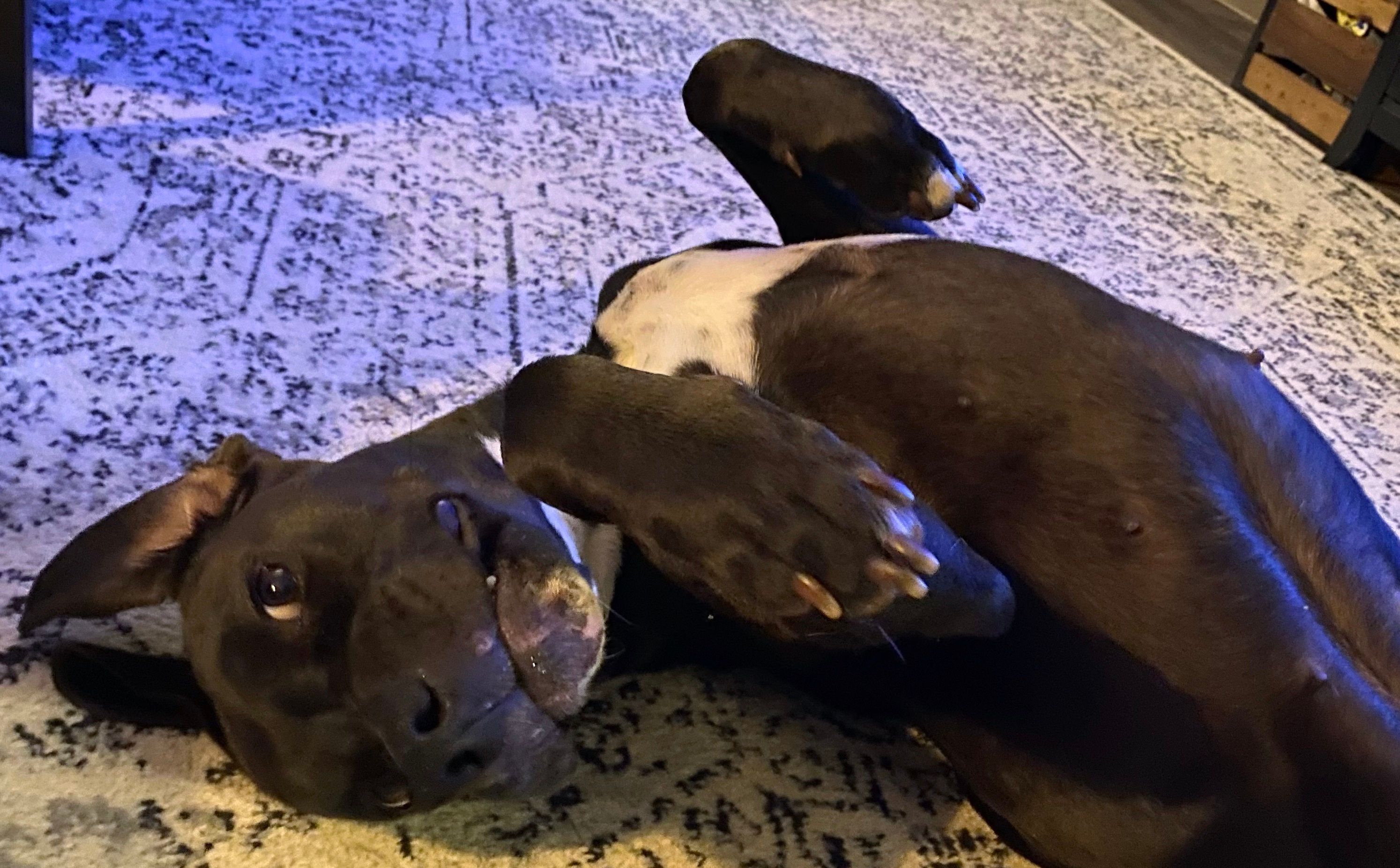 Living life at 110%
Living life at 110%
 Getting along with Jinx
Getting along with Jinx
I look back and think, remember when I thought she was light brown? Her coat is a deep brown with a white blaze on her chest and chin, her toes all socked as well, but she’d been outside so long she’d turned dusty. Her manners have improved. We only have to remind her to not run full speed into Jinx about once a week instead of every five minutes. She doesn’t try to leap out every door that opens, she can be called back from the fence when she’s chasing our neighbor’s dog, and she takes naps by my feet while I work. She still lives life at 110%, snoring with the vigor of a hibernating bear, and she’s topped out at 58 pounds, her muscular legs taking about 10 pounds each of that, I swear. She still wants to snuggle when she can, but will also wander off to curl up on her bed or lay in the sunshine, and doesn’t leap to her feet to make sure I’m not abandoning her every time I run into the kitchen. She had some behavioral training, and some of it stuck, but still pulls when she’d on the leash as if she must see around every corner and always be at the head of the pack. Even Jinx has warmed to her, taking delight in chasing her up the stairs to get her away from some random item Jinx has decided is hers, or trying to tackle Belle herself in the backyard.
A year on, she’s ours. We can’t imagine giving her up.
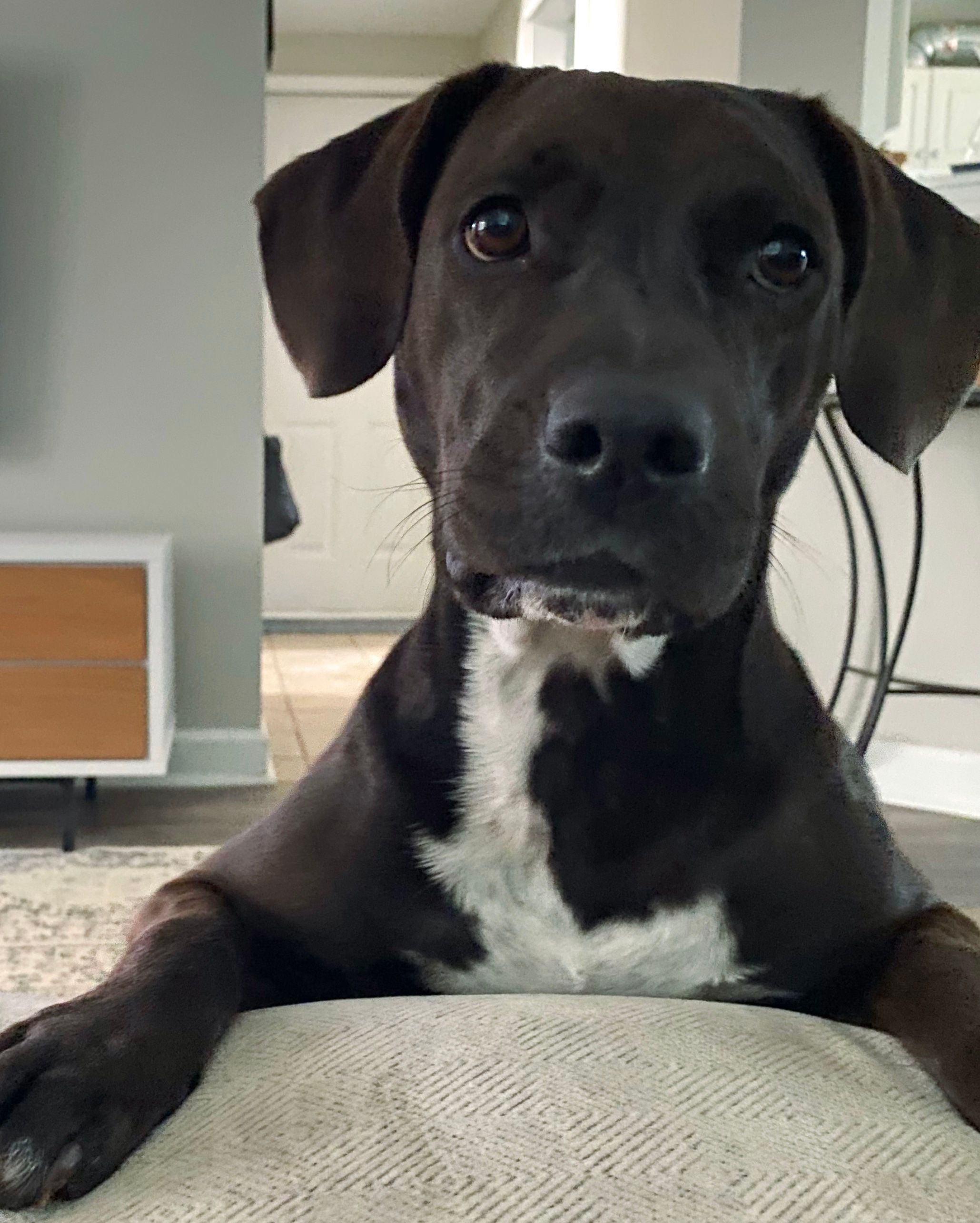 She’s got the puppy eyes nailed
She’s got the puppy eyes nailed
9 July 2022
personal-life
dogs
A while ago–okay, more than a year ago, which is a bit wild–I wrote a post about my nebulous sense of guilt for not being a wide reader, for rereading more frequently than I pick up a new book, for reading mostly books written by white American men. This is a guilt that still haunts me, but ever since writing that post, I have been reckoning with the root of the problem.
The people who speak into my life have all had very similar lives.
When I talk about someone speaking into my life, I’m considering not only my friends and family, but also the podcasts I listen to, the books I read, the tv shows and movies I watch, the YouTubers I subscribe to, and the people I follow on social media. Each individual person is speaking their thoughts out into the world, and I am on the other end, listening. So if every person whose thoughts are coalescing in my brain and forming my ideas about the world is built from a similar mold, my ideas about the world will only fit the same mold, and the cycle will repeat.
There are problems inherent in saying “you need to read more black authors” or similar phrases. It implies that the reader is going to be reading a book solely to experience a specific truth rather than approaching the book as if it expresses a general truth. We as a society rely on white authors to give us the universal knowledge of the world, and use minority authors to give us details outside our experience. If we go in knowing that tendency, however, we can combat it and begin to expand our view of the universal truths of the world.
So, slowly, over the past year and a little longer, I have been trying to change who speaks into my life. It’s a slow process. The work will never be done, but I thought I would share some moments from this journey that struck me.
For the longest time, most of my podcast listening has been a subsection of the biggest podcasts in the world–99% Invisible, Criminal, Planet Money, etc.–tech podcasts, usually about apple products or YouTube due to the nature of my entrance into the podcast sphere, productivity and creativity podcasts, and history podcasts. Most of those podcasters were of the same mold again. I tried adding more podcasts from different people, different cultures, but time is not limitless and I would fall back on my rota of top podcasts.
Then, one day, I was listening to a favorite, and it struck me that I no longer agreed with anything the host was saying. It was a productivity podcast and the specific topic is lost to me by now, but the host–an older white man living in California–was talking about how productivity just takes discipline and focus, and that he never needed therapy or help dealing with a disability because he had been meditating for years. I felt as though I was being told that because I need therapy to help me manage depression and anxiety, and medication to help me manage my ADHD symptoms, and needed to adapt to suit my desire to do anything and everything, that I wasn’t ever going to be productive. And seconds after my brain processed that message, some of the others who had been speaking into my life whispered back to me, he’s wrong, you are legitimate no matter what support you need. In that moment, I was glad that I had grown and changed and found people who could help me reckon with this moment, and the instant I parked my car in my driveway, I opened my podcast player and removed that input from my life. Boom, gone.
Less than a day later, the same happened with a book review podcast I’d listened to for years. I listened as the hosts talked about yet another white American male author writing a groundbreaking book. Can’t even remember what the book was about! And I thought, what is this giving me? When the answer was nothing, I deleted that podcast as well. This purge happened over and over, and like magic, different voices began to take their places.
I found a handful of book review podcasts hosted by women and tested them out. I kept three that spoke to me, including one that was taking an entire episode to recommend books across genres written by Asian and Pacific Islander authors for AAPI month, discussing the ways each book had influenced them. I subscribed to a podcast about wildlife biology hosted by a Black, female scientist who goes into detail about how her race and gender affects her experiences to this day in her profession. I pivoted from general tech podcasts to one about the intersection of tech and disabilities. I added history podcasts about the lesser known aspects of history–not just the Romans and Greeks or the history of Europe’s elite–covering things like the fall of the Khmer Empire, or an in-depth analysis of Monica Lewinsky (rather than Bill Clinton), or the history of tomatoes! Add in a podcast about native habitats, another on the effect diet culture has on society, a few roleplaying game themed shows with a variety of hosts, a poetry podcast focusing on a different poet every episode, and a movie podcast that examines the portrayal of women in film, and I suddenly had a wide variety of new voices in my life. It happened quickly at first, but has slowly continued, with new voices rotating in to help me view the world through a wider lens.
More recently, I rearranged our bookshelves to put the books from my partner’s youth as well as my own in a section by themselves, as they’re less likely to get our attention these days. Then the fiction we’ve read as we’ve grown up and become adults, and the nonfiction we’ve accumulated over time, separated out and waiting for us to revisit them. The unread books, the books we haven’t yet experienced, the books we want to read again to refamiliarize ourselves with them, they got a place of honor–closest to the door at eye height–so that we can find them at a moment’s notice. I realized that among those special unmet friends, there was a massive range of diverse voices that I hadn’t yet tapped, and all because they had been out of sight, out of mind. It led me to rearranging my digital book collection as well, removing books I would never read again, categorizing my favorites and leaving my unread collection front and center. It was in this process that a new voice called to me.
I had purchased The Peace Keeper by B. L. Blanchard some time ago but never opened it, instead seeking the comfort of a favorite series over and over. But sitting there on my digital shelf, it spoke to me, asking me to let it tell me what it knew. So I opened it, and was drawn into a world where North America was never colonized by Europeans, where the Anishnaabeg had continued to hold on to their nation with no set borders around what I would call the Great Lakes. It was not a philosophical fiction about how the world would be different, not really; instead it was a murder mystery thriller surrounding the main character Chibenashi, an Ojibwe detective who lived in a world that was not novel to him. He moved through the universe of the book as if everything was self-explanatory, his life showing me a handful of universal truths while it highlighted the cultural differences between his fictional ancestors and my own.
This, I thought, is why I want to read more books by people who are not like me.
From maps oriented with east at the top of the page because the Anishnaabeg consider east the direction that orients them to the world where I would use north, to art focused on the miigis–the beings who taught the Annishnaabe people their way of life–and Sky Woman, to the cultural significance of a person’s doodem or clan, the story spoke to me of a world that I had never dreamed of. The world through which Chinbenashi lived was not perfect, and he was ashamed of parts of it as I am ashamed of parts of my cultural legacy. Universal truths written in a voice I had not heard before. It has changed me for the better already.
The overall diversification process is ongoing. I’m in a book club that’s encouraging me to read books I wouldn’t have chosen for myself. The same could be said for the movie club I’ve joined. New podcasts enter, old podcasts leave. I’ve subscribed to the magazine Poetry to start reading a genre I rarely experience except by accident. My social media feeds are filled with people who do not look like me, who do not think like me, who do not live like me. I have never felt so in love with the world, so happy to hear the voices of those who would tell me I do not have the whole picture.
6 July 2022
books
podcast
diversity
























